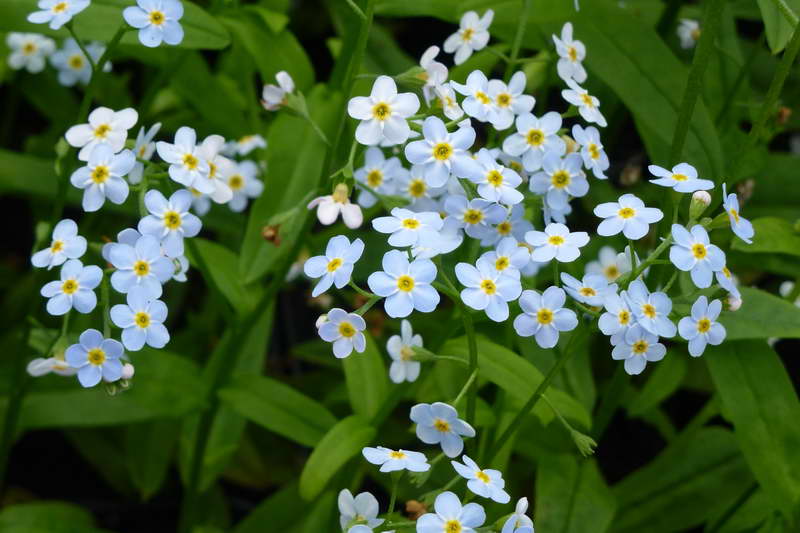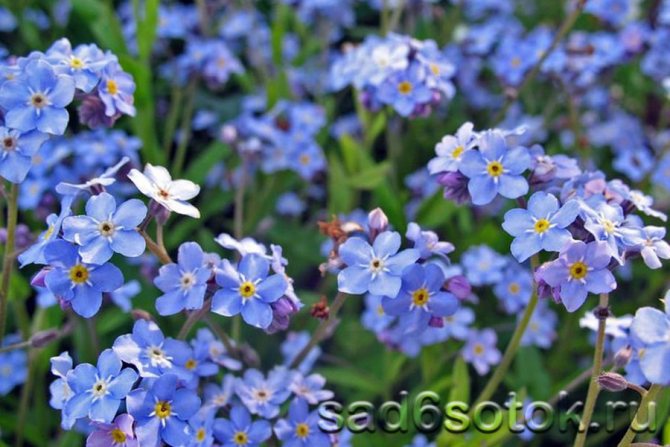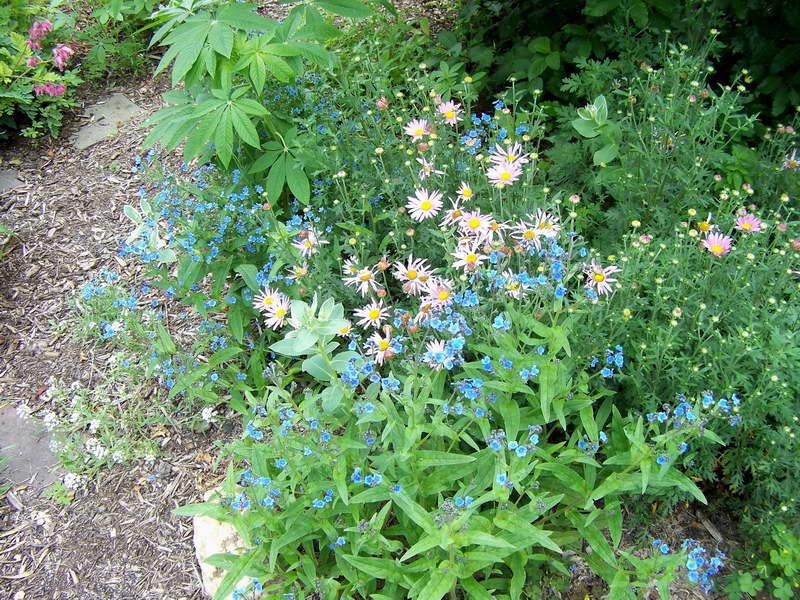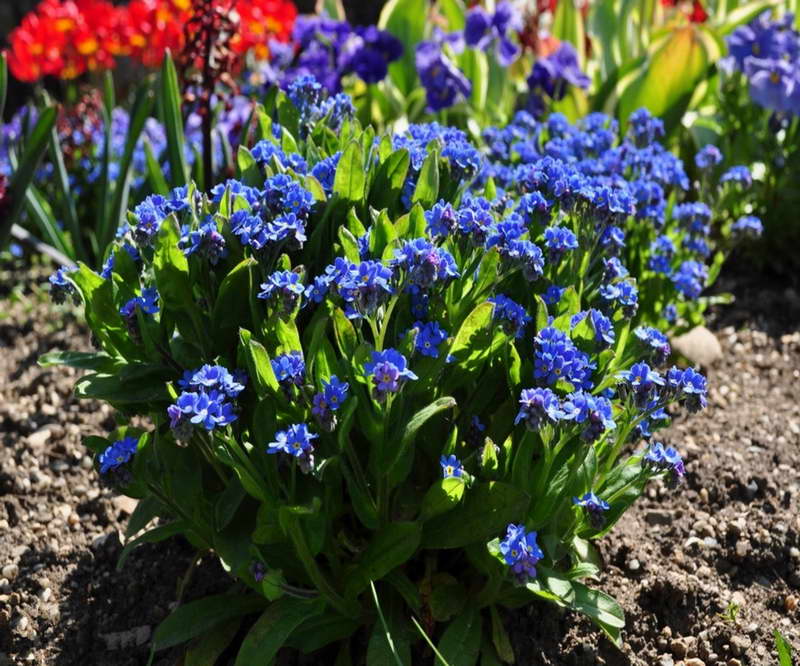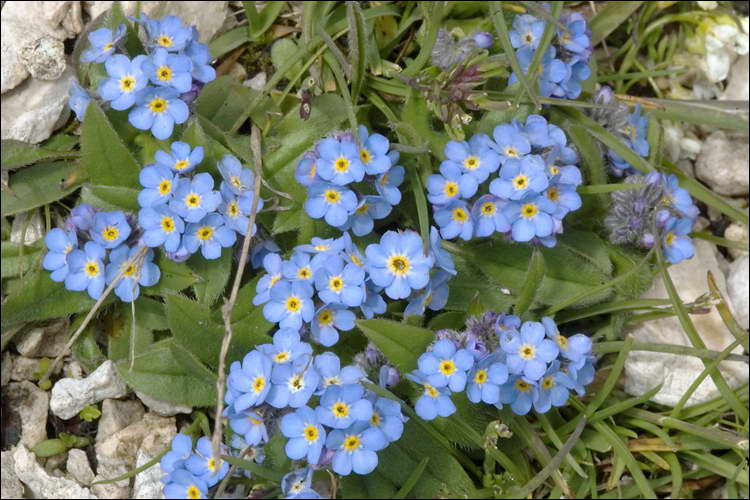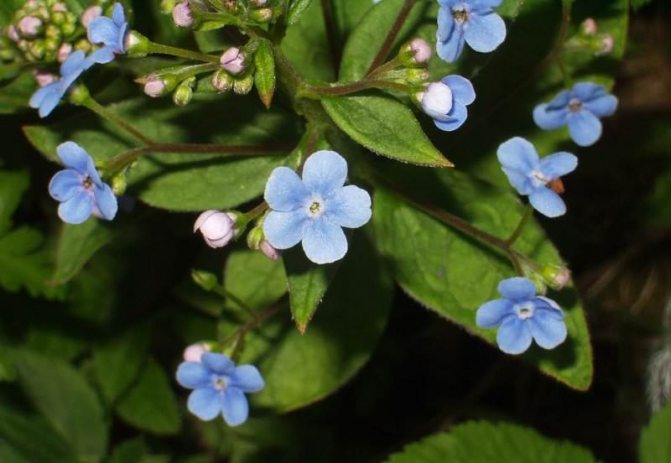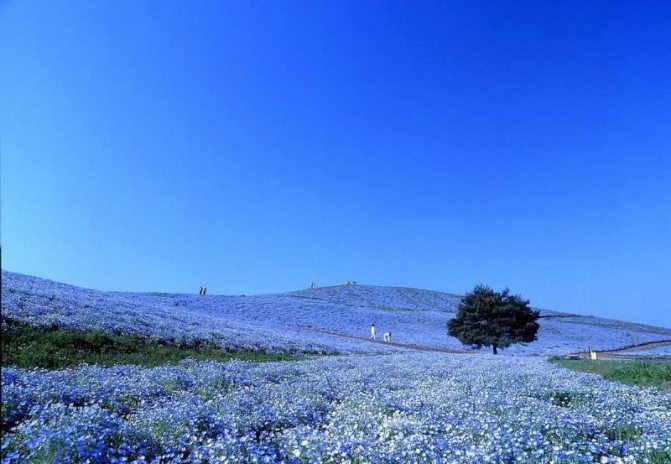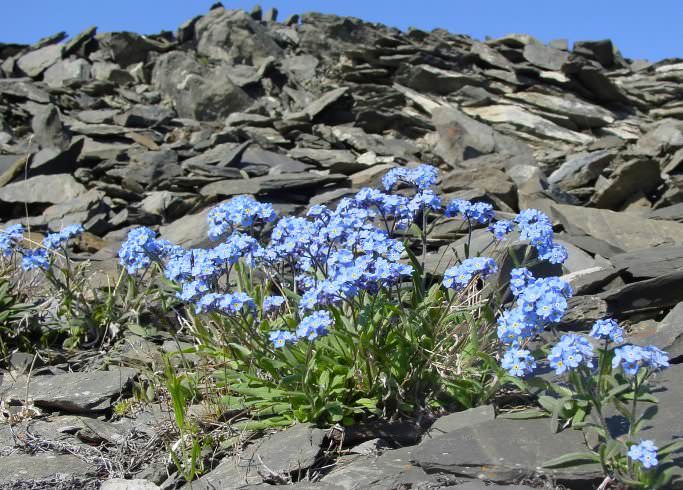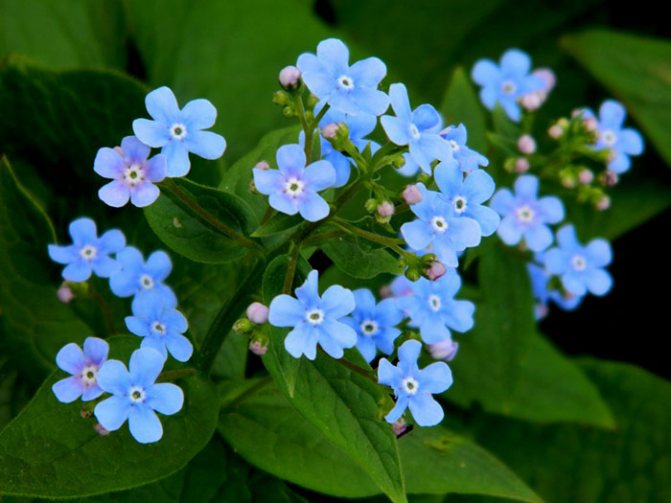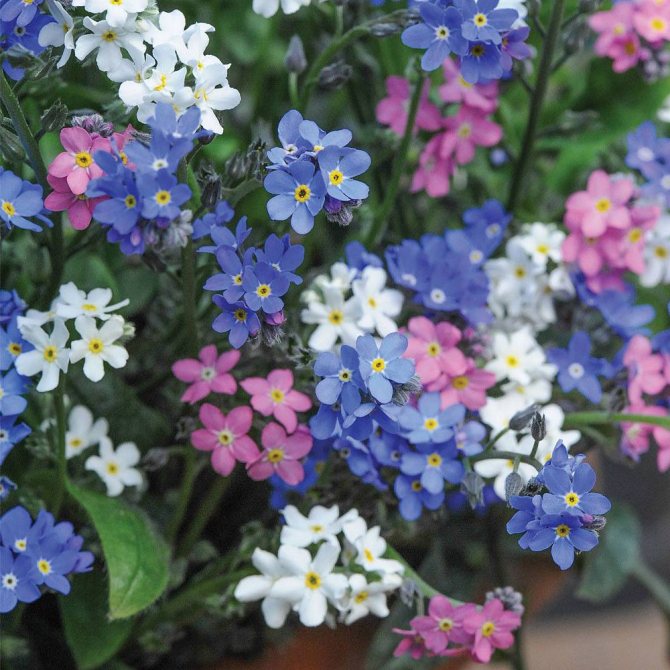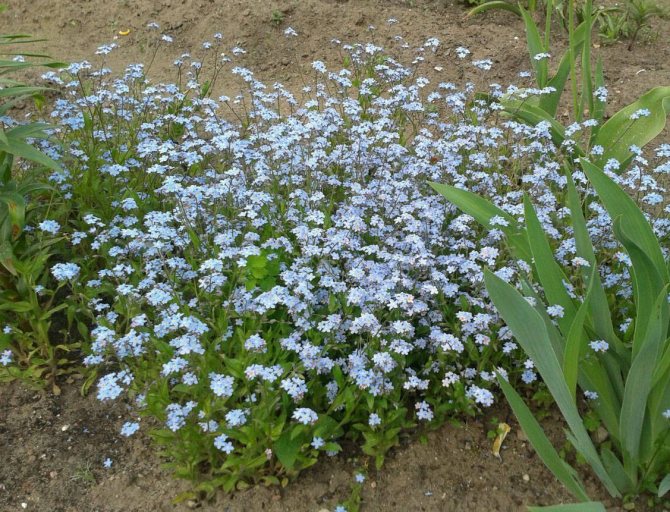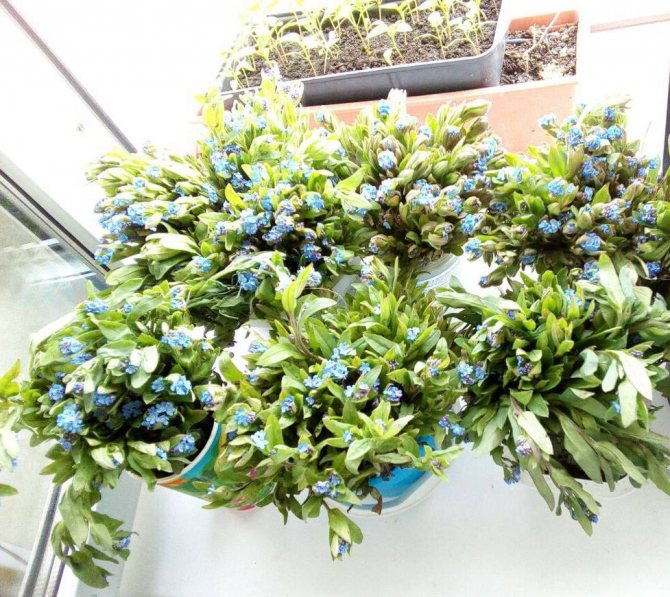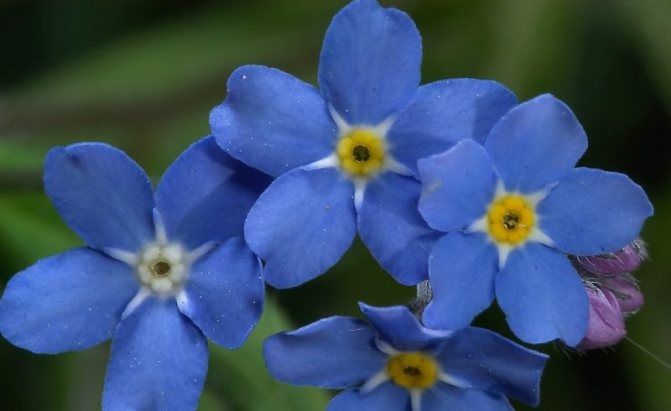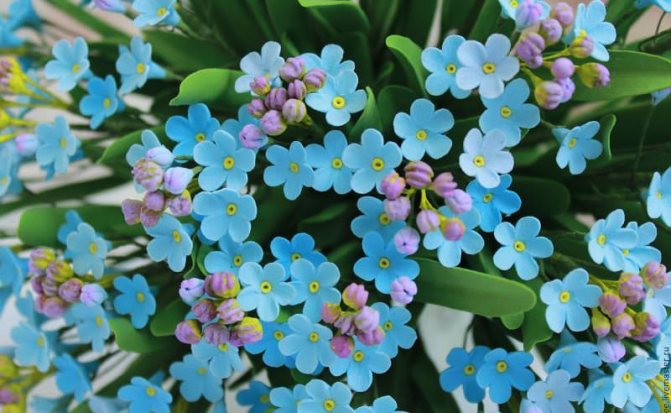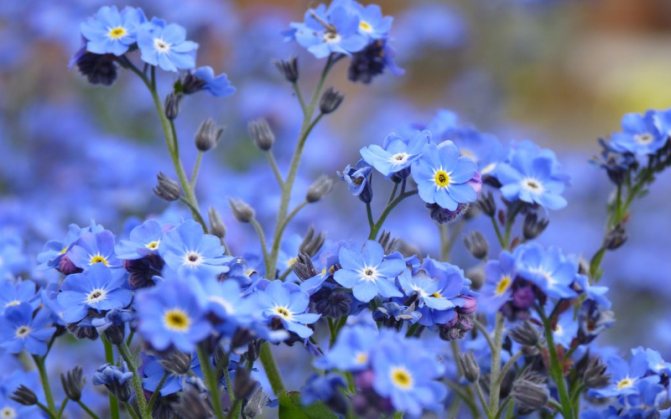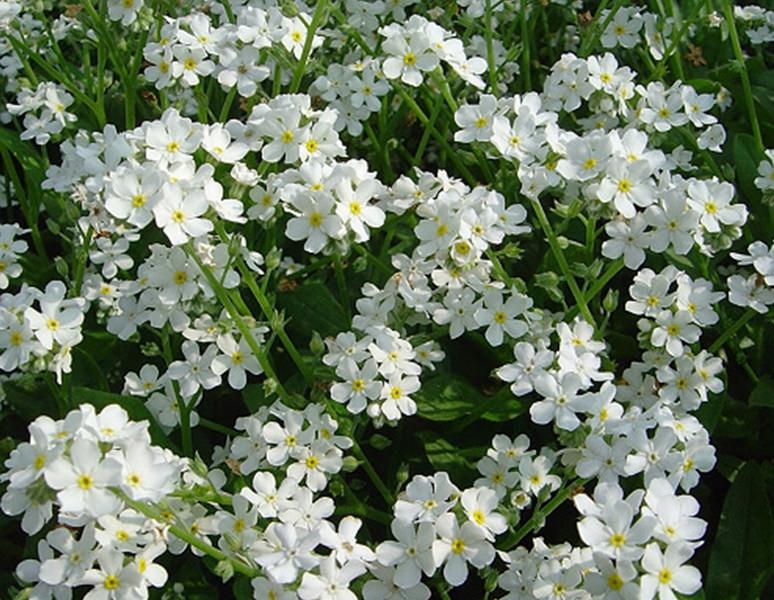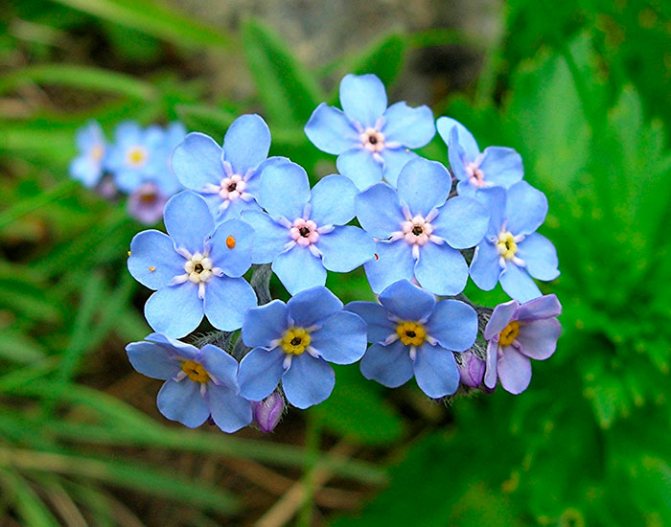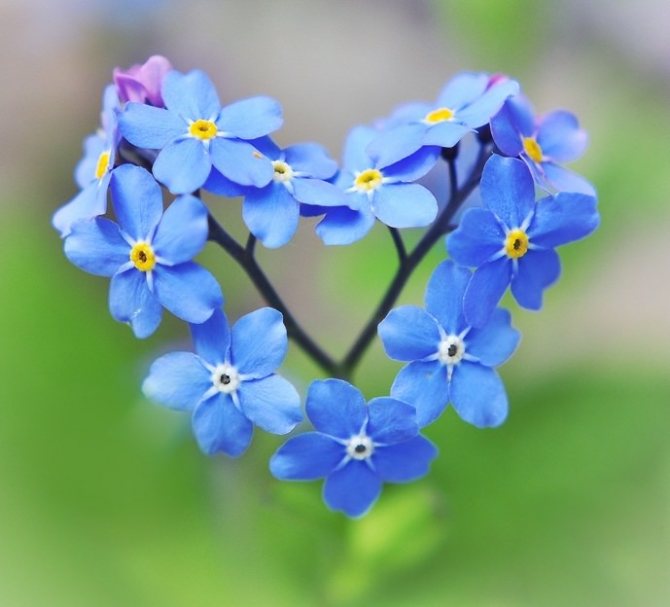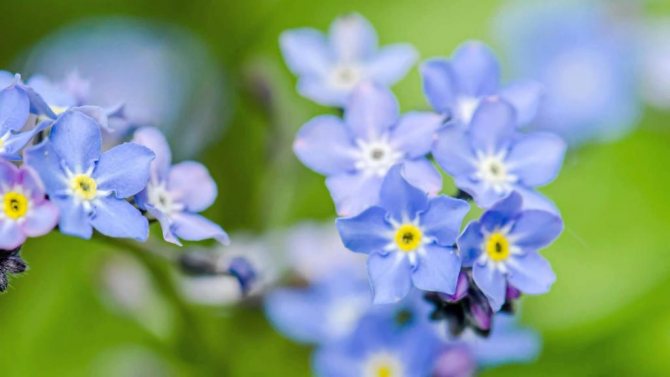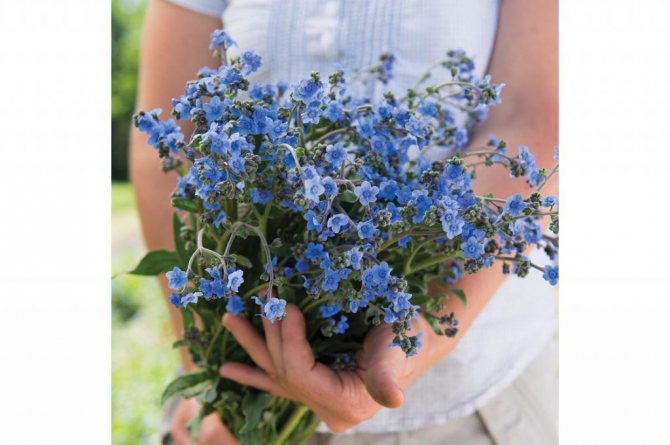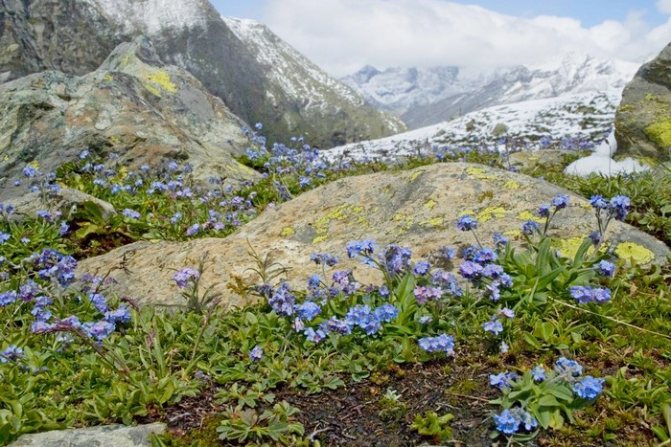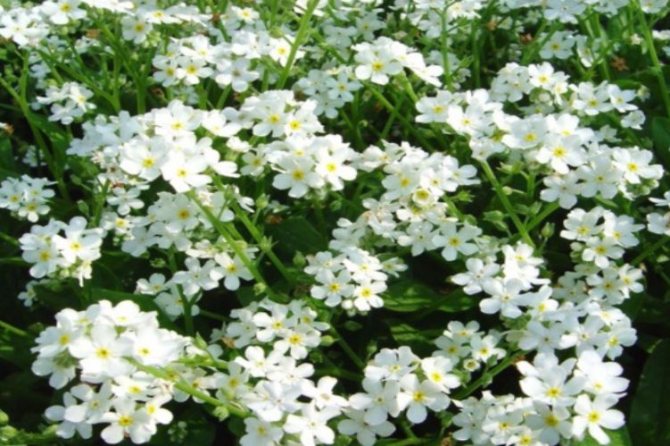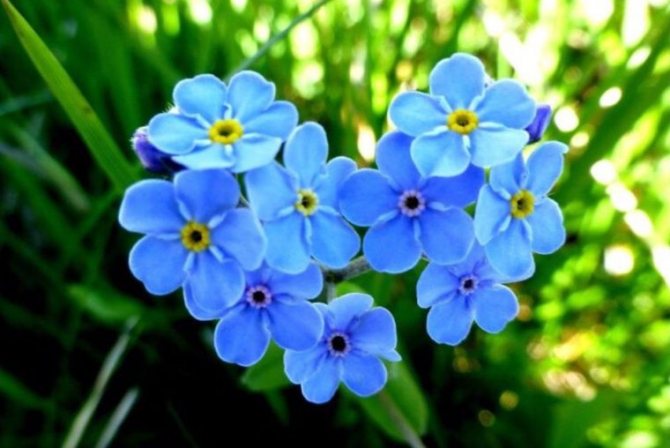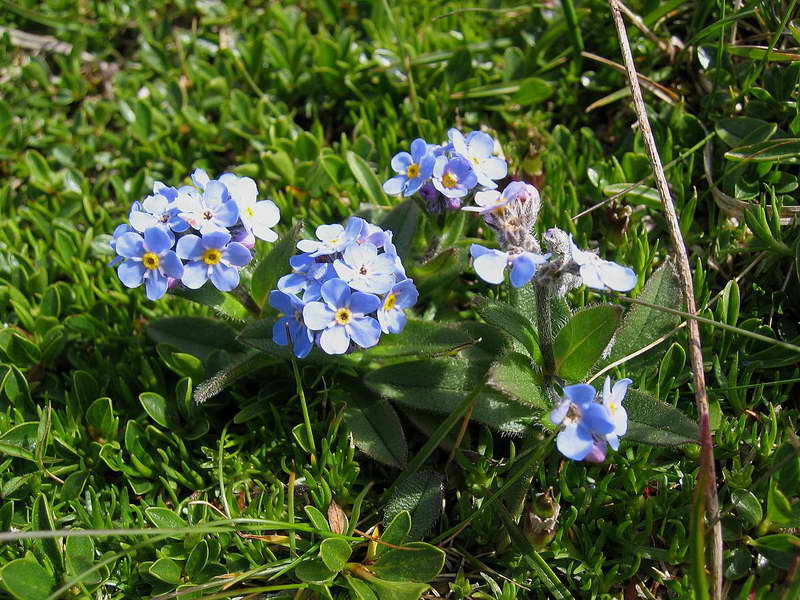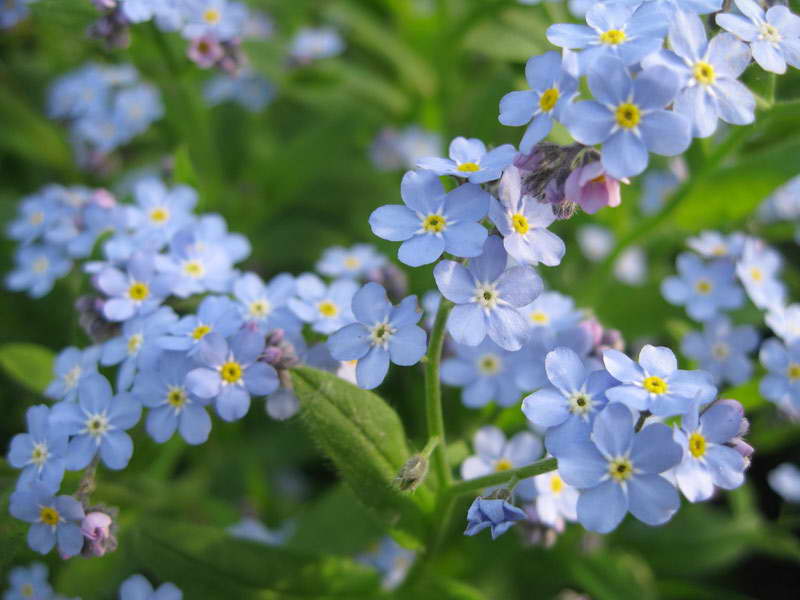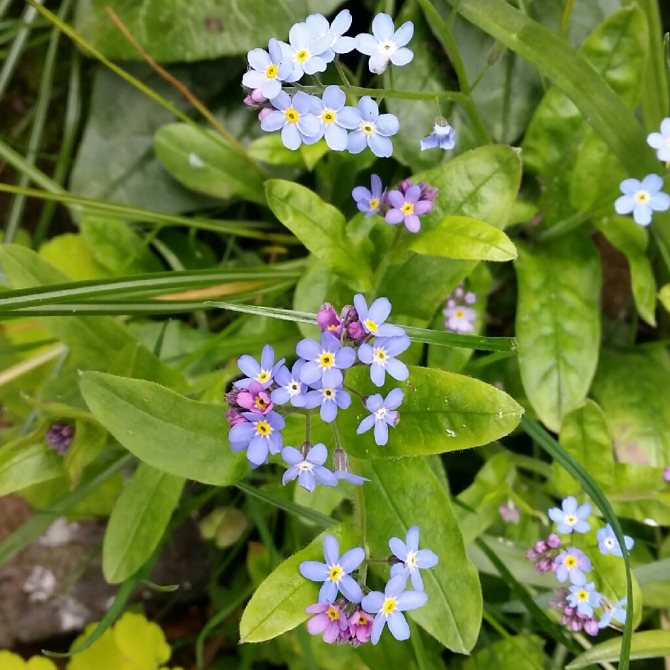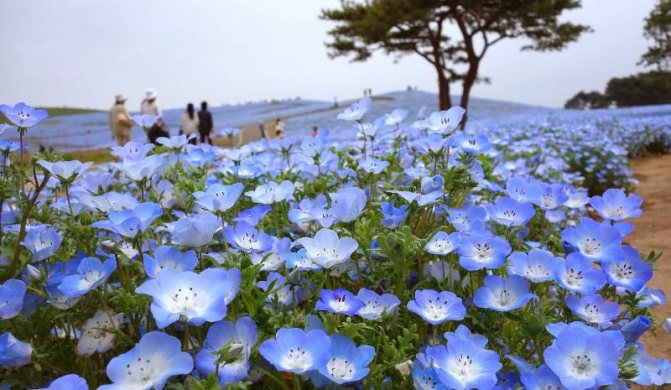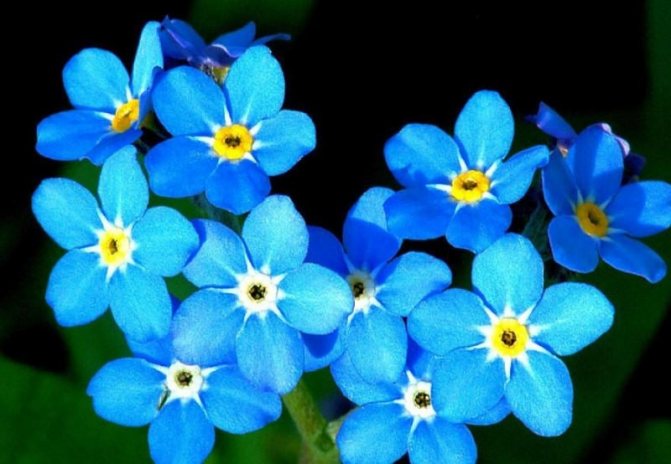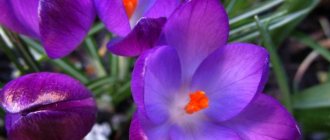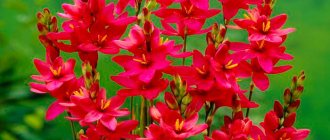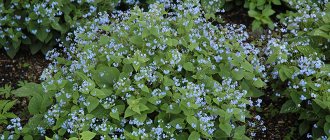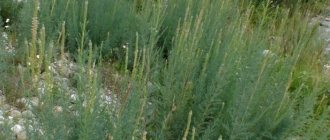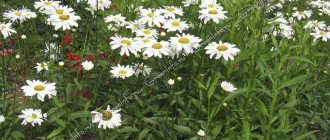From time immemorial, touching blue flowers have attracted the attention of lovers. For many peoples, forget-me-not has always been considered an invariable symbol of fidelity and memory.
Planting and caring for a picky spring flower in the open field did not cause much trouble for flower growers, therefore, both earlier and now the plant is popular in various types of flower beds and garden styles, it is still loved in all corners of the world.
It is difficult to determine the homeland of the plant, in some sources they call the Swiss Alps, in others they simply indicate the northern and temperate regions of Europe.
The delicate flower is very common not only on the European continent, but also in America, Asia, southern Africa, as well as in Australia and New Zealand.
There are so many legends about him composed by different peoples, but they all boil down to one thing - love and fidelity are above all life circumstances and it remains to live in human memory for many years.
In all languages, the name of the flower means approximately the same - “do not forget me”, but the official botanical name of the genus Myosotis in the Borage family is translated from the ancient Greek language as “mouse ears”.
Indeed, opening out from the bud, young fluffy forget-me-not leaves really look like a mouse's ear.
Description of garden forget-me-not
Forget-me-not garden blue, alpine and any other belongs to the genus of forget-me-nots (Myosotis) of the Boraginaceae family. In total, there are about 80 species in the genus Myosotis, and 30 of them grow on the territory of our country. Other types of forget-me-nots can be found in the temperate climate of Europe and America, Asia and South Africa, New Zealand and Australia. Forget-me-nots are herbaceous plants that prefer moist and shaded places.
The height of the highly branching stem of this plant can vary from 10 to 40 cm. It has sessile leaves of a pointed lanceolate shape. The petals of its many colors can be blue, blue, pink, white and even cream. The garden forget-me-not forms racemose inflorescences. It blooms from May to mid-July, after which it forms fruits - nuts, in which black, very small oval-shaped seeds ripen. When the fruit cracks, the seeds fall to the ground and germinate. As a result of such self-seeding, a fairly strong seedling is obtained, capable of overwintering in the conditions of our winters.
Forget-me-nots - planting and leaving
Forget-me-not from the Burachnikov family is often called the queen of May. Glades of a heavenly hue appear in late spring on forest edges and meadows, but these are wild species.
Many flower growers are already accustomed to the fact that their site is invariably decorated with a variety of decorative forget-me-nots, planting and caring for them always pays off handsomely.
A pretty plant will enrich the flowering range with spectacular gentle strokes. It is not for nothing that in many languages the essence of the name of a modest beauty is preserved - “do not forget me”. There are at least 50 hybrid species, and they are used in floriculture. There are, of course, many more varieties.
The flowers can be blue, light blue, pink, purple, cream, white, and even with a tiny yellow center. The height of the plants also differs, for example, the Alpine forget-me-not rarely reaches 20 centimeters, and the garden one easily reaches 35 cm. It usually blooms from May to the end of June.
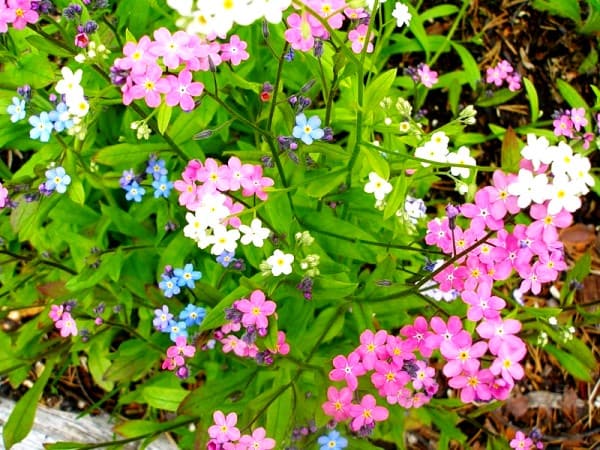
Forget-me-not garden
All varieties are distinguished by genetic plasticity, i.e. when grown from seeds, retain their properties. However, most flower growers are already convinced that even a perennial forget-me-not will not please for more than two years. The inflorescences will become scarce, the stems will become excessively elongated.
Choosing a place for planting forget-me-not garden
In order for forget-me-nots and its flowers to delight you when growing at home, you need not only to choose the most suitable type for you, but also to plant it correctly. A plant like the garden forget-me-not prefers loose, moderately nutritious and moist soils with good drainage in light shade. The flower can grow in the sun, but it manifests its decorative qualities most fully in partial shade. It is a mistake to believe that the sun will increase the flowering period - on the contrary, the flower petals will "burn out" from bright sunlight. Do not plant forget-me-not on very rich soils, as the plant begins to "fatten" and forms a powerful bush that practically does not bloom.
Forget-me-not beneficial properties
Forget-me-not petals contain anthocyanins, due to which the petals turn blue. These substances largely determine the medicinal properties of the plant - it eliminates inflammation, helps to remove phlegm from the lungs and reduce sweating, and stops the blood. Basically, in medical practice, juice and powder are used in the treatment of cancerous tumors of the oral cavity and organs of the reproductive system, less often - a decoction from the roots externally for eye diseases and as an additive for baths for skin rashes and dry eczema.
A discreet flower with petals of heavenly blue - forget-me-not in Latin is called Myosotis, which means "mouse ear".
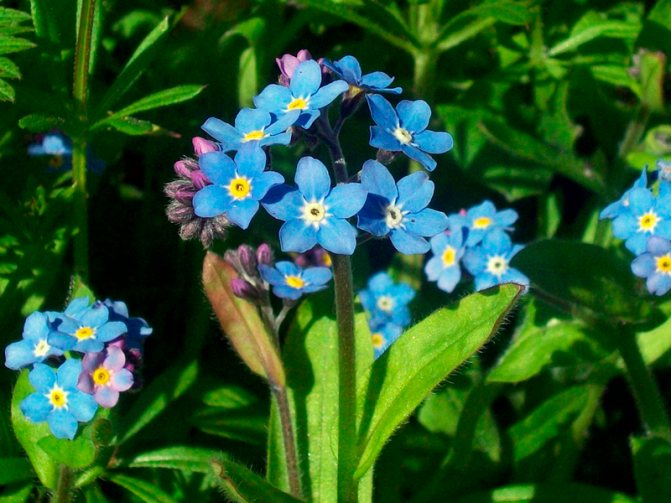

Many legends and popular beliefs in most countries of the world are associated with it. They are united by a common meaning - since ancient times, the plant has been considered a symbol of fidelity, good memory.
Growing seedlings of garden forget-me-nots from seeds
Growing forget-me-nots from seeds is the most common breeding method for garden forget-me-nots. You can grow forget-me-nots both through seedlings and by a seedless method. At the same time, forget-me-not is mainly grown from seeds. Most often they are grown as a biennial plant. Prepared seeds must be dipped in slightly salted water. The floating planting material must be thrown away, most likely, it will not be able to germinate. The remaining seeds must be dried. Like all biennials, forget-me-not seeds are sown in May-June on seed beds or in bowls with loose fertile soil. Seeds are sown superficially on a compacted, moist, flat soil surface and only slightly sprinkled with light soil or sand. The crops are covered with spunbond, polyethylene or glass, the soil is kept moist by watering gently from a spray bottle or over a non-woven covering material. The first seedlings appear literally after five to six days. After germination, the crops are freed from the shelter. When two true leaves are formed (usually after 3-4 weeks), the forget-me-nots are pulled or planted in pots (1-3 plants) or on growing beds at a distance of 5-7 cm between the plants. For the bushes to be compact, the cultivation of forget-me-not seedlings is carried out in partial shade. Seedlings are periodically watered, the soil is loosened, weeds are removed. For better tillering, the seedlings are pinched. Forget-me-not is fed with complex mineral soluble fertilizer for seedlings once every two weeks. The fertilizer concentration is gradually increased. In late August - early September, forget-me-nots form a dense rosette of leaves. In this form, they are planted in a permanent place according to the scheme recommended for the variety (15-25 cm between plants) and watered well
Mister Summer resident informs: forget-me-not is a healer of the respiratory tract
In addition to unpretentious decorativeness, the pristine is appreciated for its medicinal properties, known for a long time. Traditional medicine uses the plant as a hemostatic, anti-inflammatory and expectorant. Treatments for bronchitis, some forms of tuberculosis and pulmonary lesions are effectively complemented by the humble flower.
Raw materials for the preparation of medicinal compositions are prepared during flowering. Use the entire aerial part - stems, leaves, inflorescences. Drying is carried out in the shade in a ventilated room or under a canopy, where there is no draft. Then the raw materials are crushed, stored for up to a year in glass, ceramic or paper bags.
When harvesting forget-me-not flowers for medicinal purposes, take into account that varietal and hybrid forms are not suitable for these purposes.
The best raw materials are considered to be field and forest species, ideally wild ones. Some folk recipes using forget-me-not herb:
- With bronchitis, residual cough, fevers, 3 tablespoons of dried raw materials are poured with a glass of boiling water. Insist for an hour, then filter. Drink a tablespoon three times a day after meals.
- Tea brewed with the addition of forget-me-not (1: 1) helps with asthma, upset stomach or intestines, kidney disease.
- A decoction of two teaspoons of dried herbs in a glass of water helps with impotence.
- Fresh juice of leaves and stems is used as an adjuvant in the treatment of malignant lesions of the oral cavity.
- Green parts chopped into gruel are an excellent hemostatic and wound healing agent. The mass is applied to open wounds, burns, frostbitten areas.
Scientists have not identified contraindications to the use of medicinal decoctions and forget-me-not infusions. But pregnant or lactating women, as well as people with allergies, should first consult a doctor.
Some housewives use delicate flowers for culinary purposes. For example, they sugar and decorate ceremonial pastries - cakes or pastries. Or frozen in water to decorate cocktails.
«>
Planting seedlings of garden forget-me-nots
Forget-me-not seedlings are grown until the plants grow up to four to five centimeters in height. After that, you can plant seedlings in a place of constant growth with an interval of fifteen to twenty centimeters.
Some sources indicate that it is necessary to plant young forget-me-nots in open ground at the end of August.
A distinctive feature of forget-me-nots is resistance to transplants. After moving to open ground, almost all plants survive. But it is extremely important for this to water them well after transplanting. For the winter, forget-me-nots are mulched with fallen leaves, spruce branches or peat. Forget-me-not bloom comes next spring. Garden forget-me-not will bloom earlier if temporary shelters are built over it in April. In the second year of cultivation, in order to prolong flowering and limit seed formation, wilted flowers are promptly removed.
Vegetative propagation
Hybrid plants are best propagated vegetatively: by cuttings or by dividing the bush.
Propagation by cuttings
Cut the apical cuttings into a length of 4-5 cm, plant them for rooting immediately to a permanent place of growth, to improve the process, cover on top with a glass jar or a cut plastic bottle. Carry out the procedure in the spring (around the end of April), the flowering period will begin this season, but it will not be particularly lush.
Dividing the bush
The division of the bush can be carried out throughout the season (even during flowering). Thanks to the fibrous root system, they quickly take root.
Reproduction methods for forget-me-not garden
Forget-me-nots are becoming more and more popular among flower growers and appear in flower beds more and more often. Various methods of flower propagation are used, which we will talk about. When to sow forget-me-not seeds? The best time to plant this wonderful flower with seeds is July, since the soil is already warm enough, and there is still a month for the seed to adapt and root.Before planting, mix the soil with humus, moisten a little, make shallow holes and pour forget-me-not seeds into the open ground. Seeds need to be sprinkled on top with a little sand, covered with a film, which must be removed after 2 weeks. The first 2 weeks after sowing, you can not remove the film, water the seeds. They should "rot", then the plants will root better.
Cuttings are the most popular propagation method when working with forget-me-nots. For cuttings, it is necessary to choose a well-grown bush and cut off the tallest cuttings just below the set stem. The stalk must be placed in water until it takes root. Then it is planted in the ground. To do this, shallow pits are made in the prepared soil (moistened, fertilized with peat and humus), plants are planted in them and a little sprinkled with dry earth on top, watered at the root. After 5 days, you need to fertilize. It is better to take a universal one, making sure that there is no ammonia component in its composition.
Reproduction of forget-me-nots by dividing bushes is not as difficult as it seems. The root of the flower is very sprawling, and you can separate it with one movement of the pruner. It is necessary to gently shake off the ground from the root of the plant, select a part of the rhizome with a "knee" (bend), cut it vertically. For better engraftment, the roots can be dipped in a universal fertilizer solution. Then the bushes are planted like ordinary seedlings. After dividing the bushes, the next year, the seeds will scatter themselves, and there will be much more bushes, which should not be allowed. It is necessary to thin out the bushes, because if the forget-me-not is planted too densely, this will lead to the fact that the color will be less abundant and bright.
Forget-me-not: planting a plant
This culture loves the sun, but it is still better to plant it in partial shade. Then the color will become saturated. In open ground, forget-me-not is often planted with seeds, because the plant demonstrates excellent germination. It is best to land in July. The culture will bloom next year.
Prepare the soil. The soil should be nutritious, loose, light and well-drained. The latter can be done manually by digging in several medium-sized stones in the area at a depth of half a meter. It is noteworthy that forget-me-not does not like too nutritious soils. In such conditions, the plant will bloom poorly, but it will grow strongly. But depleted sandy soils do not suit him either.
The planting process will consist of the following stages:
- Dig up the ridge.
- Apply fertilizer - humus combined with peat. Norm: up to 5 kg per 1 sq. m.
- Add nitrophosphate: 1 tbsp. l. for 1 sq. m.
- Dig up the area again, level and lightly tamp the surface.
- Make shallow grooves. Sprinkle the seeds and lightly sprinkle them with sand. The distance between the landing points is 10 cm.
- Press down gently with your hand. Stretch the covering material from above.


With proper care, the seedlings will appear in about 2 weeks. Remove protection and thin out the seedlings. Sprouts can be transplanted. Maintain a 5 cm distance between them. At the beginning of autumn, all forget-me-not bushes should be planted in a permanent place.
Garden forget-me-not care
It is very easy to take care of these unpretentious flowers, they only need careful watering at the root so that water does not fall on the green parts of the plant, and the loosening of the soil layer. Do not flood the plants, or they will rot or get sick. If the soil is constantly dry, then forget-me-nots, as a rule, fade very quickly. In order for the plants to multiply by self-sowing, select a few bushes and leave faded inflorescences on them so that the nuts and seeds ripen. For the rest of the forget-me-nots, remove the inflorescences after flowering, otherwise they will fill the entire area. You can transplant forget-me-nots to other places both in the fall and during the period when they already have buds or flowers, these plants tolerate transplanting very well.In spring and autumn, you can feed forget-me-not bushes. To do this, add to 10 liters of water and stir in a teaspoon of nitrophoska, potassium sulfate and urea. You can also take mineral complexes ("Flower", "Emerald", "Agricola"). Cruciferous fleas, aphid colonies, slugs, scoops can damage forget-me-nots. Diseases that can affect plants: rot (root and gray), powdery mildew (real and false). For the prevention of rot, forget-me-nots can be treated with the preparation "Hom", and for powdery mildew - with "Skorom" or "Topaz". When aphids appear, spraying with Iskra should be carried out.
If the winters in your area are harsh, then in the fall, mulch forget-me-nots, cover them with spruce branches.
If you are very fond of these modest blue flowers, then in the fall you can dig up one or more plants, transplant them into pots. They must be stored in the basement (the temperature there should not fall below zero). In February, transfer them to the room, place them on the windowsill. Then, in March, forget-me-nots will delight you with abundant flowering.
It is rare today to find a garden where forget-me-not grows. Flowers of a pale blue color, exuding the aroma of meadow and forest, are an integral sign of spring.
Folk legends
In our country, forget-me-nots have other names, for example, they call it a pristine, feverish herb, gourd. Different peoples have different legends associated with this flower, but they are all united the concept of fidelity and good memory... In Greece and German folklore, there is a legend about a shepherd named Likas, who gave his bride, saying goodbye to her, a bouquet of forget-me-nots.
They also remember the ancient legend of a couple in love who went for a walk along the river. At the edge of the steep bank, the girl noticed a delicate blue flower. The young man climbed down to tear him down, but could not resist and found himself in the river, which caught him with a strong current. All that he had time to shout, before the wave covered him is: "Do not forget me!". This is one of many legends about a lovely blue flower with a yellow eye, telling how it got its interesting name.
This flower is considered by many to be witchcraft. Since a woven wreath made of it and put on the neck or placed on the chest in the region of the heart of a loved one is able to bewitch and hold him stronger than chains. The roots of forget-me-not have the same power.
Description
This herb, belonging to the borage family, can be either annual or perennial. The branchy stem is low - from 10 to 30 cm, slightly pubescent. Basal lanceolate or spatulate leaves are dark green or grayish in color. In May, the bush is covered with a scattering of small-sized blue flowers. Blue flowers with yellow eyes, collected in short inflorescences, adorn the garden for a month.
At the end of flowering, a nut-fruit is formed, filled with black shiny seeds. There are up to 2000 of them in 1 gram. The color of the forget-me-not flower can be not only blue, but also white or pink. Usually this color is found only in the wild.
Plant characteristic


Small, usually blue, flowers on long stems.
Forget-me-not flowers can be:
- annual;
- biennial;
- perennial.
Stems are long, reaching 40 cm. Leaves can be lanceolate, sessile, spatulate, linear-lanceolate. The flowers are blue, pink, white in color. Collected in inflorescences. The fruits of the plant are small dense capsules in the shape of a nut, inside there are many black shiny seeds. They take root well and can remain viable for up to 3 years.
Varieties
For decorative purposes, in gardens, as a rule, varieties are grown that have evolved from forest, alpine or marsh forget-me-nots.
Forget-me-not forest is a dense bushes with a large number of branching shoots and a height of 20-30 cm. Flowers about 1 cm in diameter, blue, are collected in apical inflorescences. Prefers shaded, humid places.
Forget-me-not marsh is found mainly along the banks of reservoirs, streams and the outskirts of swamps. Most common in western Russia, southern Siberia, Mongolia and the Balkans. Due to the constant shoots formation during the summer, the swamp forget-me-not is a flower that differs from other varieties by a long flowering period, which lasts from spring to autumn.
This plant is perfect for decorating the shores of a small reservoir. The Thuringen variety looks spectacular thanks to its dark blue flowers, and the scorpion-shaped forget-me-not, bred in the USA, has a bright blue color with a yellow or white center.
Alpine garden forget-me-not - a perennial flower, cultivated as a two-year-old. A very hardy and unpretentious plant that blooms quite abundantly in the second half of spring. It is not afraid of either drought or spring frosts.
The most popular varieties with compact bushes and abundantly flowering are Blauer Korb, Victoria, Indigo, Blue Ball, Music, Miro, Compinidi, etc. With the help of these varieties, you can get blue islets of various shades in the garden. The color of the forget-me-not Rosilva or Carmen King flower is pink.


This allows them to be used to create original compositions. Some other plants belonging to the borage family are sometimes mistaken for forget-me-not. For example, such as brunerra, black root or ankhusa - flowers that look like forget-me-nots. Therefore, they are often confused.
Types and varieties of forget-me-nots, popular in cultivation
The genus Forget-me-not (Myosotis) consists of more than 60 species of plants, but in household plots mainly varieties of 4 of them are cultivated, natural species are rare.
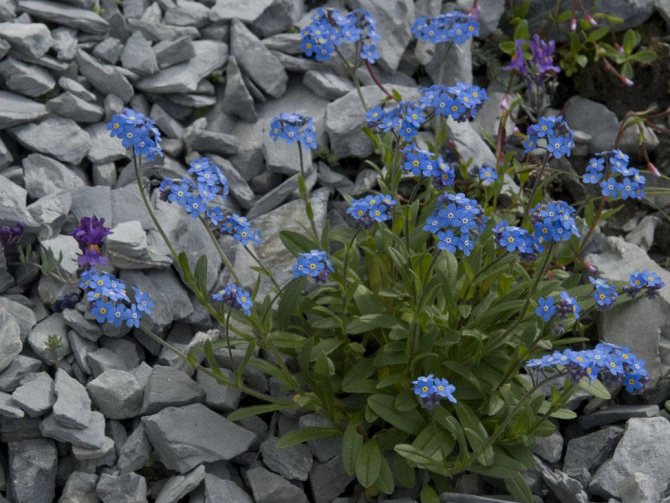

Alpine forget-me-not (M. alpestris) is a perennial low plant with a short rhizome and a dense rosette of grayish-green leaves. In May, it is covered with multiple dark azure flowers, propagates only by seeds.
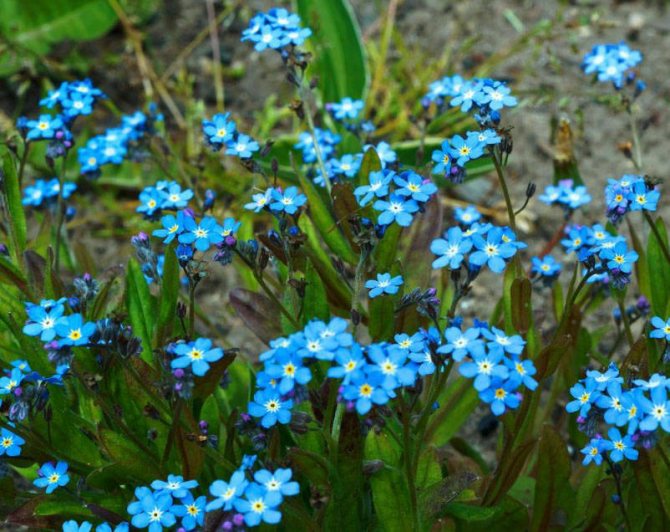

Forget-me-not alpine garden (M. alpestris x hybrida) is a perennial, which is grown in culture as a biennial herb. It begins to bloom in more southern latitudes in the middle of spring, and in the middle latitudes of Russia around the second decade of May. Flowering is long and plentiful, forms seeds by the end of June or the beginning of July.
The best varieties:
Blue Ball - low bushes about 15 cm with multiple blue inflorescences;
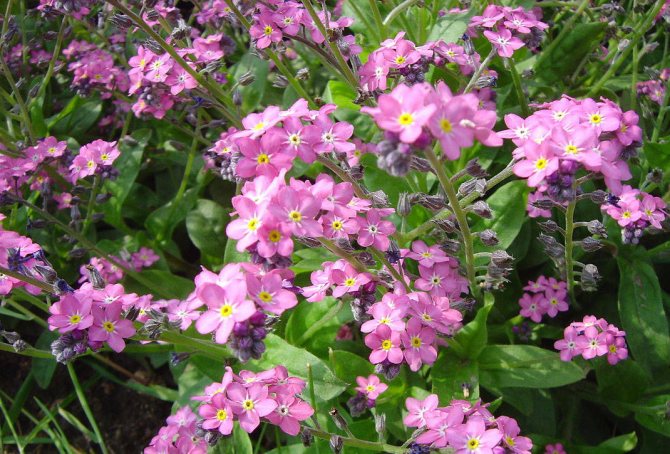

Rosylva (Rosylva) - pink forget-me-not about 20 cm high;
Indigo (Indigo) - the name of the variety corresponds to the color of the petals;
Music (Music) - a variety of garden forget-me-nots with the largest flowers in a dark blue shade;
Carmen King (Carmine King) - a plant up to 20 cm with bright crimson flowers;
Forget-me-not garden Blue basket - perennial with branched shoots 20-30 cm high and small blue flowers in loose inflorescences, winter-hardy and perfectly tolerates transplantation;
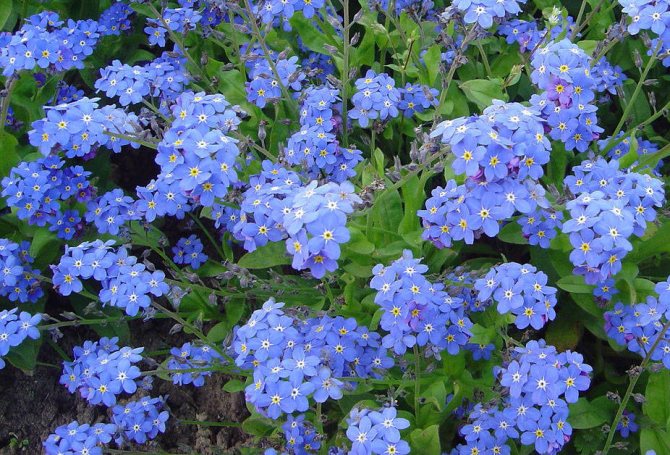

Victoria (Victoria) - a variety up to 30 cm tall with clear blue, and Victoria Rose - with pink petals.
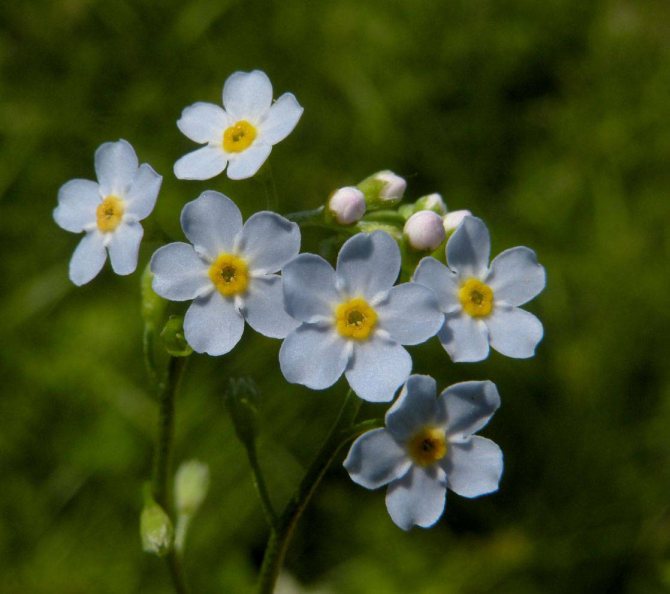

Forget-me-not marsh (M. palustris)
Perennial with strongly branched shoots, grows up to 30 cm.
The foliage is large, rich emerald, the inflorescences are sky-blue.
Propagated by seeds.
Varieties:
Thuringen - with rich dark blue petals;
Semperflorens (Semperflorens) - bred by American breeders on the basis of the previous variety, is distinguished by bright blue flowers with a sunny yellow center.
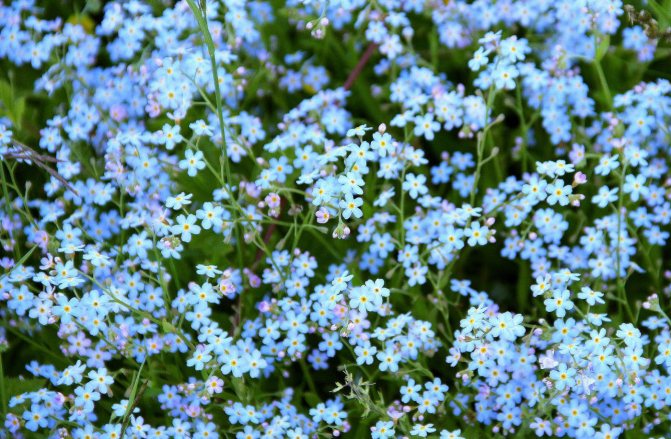

Forest forget-me-not (M. sylvatica)
A perennial that is cultivated as a biennial plant.
Bushes grow up to 30 cm high. Leaves are oblong-lanceolate.
Abundant flowering, lasts from May for 40-45 days, inflorescences-curls of a delightful sky-blue color.
On the basis of the species, a huge variety of tall varieties have been created, not only with blue, but also with pink or blue flowers.
For example, one of the most famous Blue Bird varieties, reaching 45 cm in height.


Forget-me-not (M. dissitiflora)
A perennial species, also known in the culture as a biennial with large dark blue flowers.
The varietal variety is represented by plants with white, pink and blue inflorescences.
Growing conditions
Forget-me-nots prefer shady places, but if the humidity is high, then they grow well in areas illuminated by the sun. It is desirable that the soil has enough nutrients. Watering is required only when needed. In this case, the stream of water is directed below the plant. Excessive waterlogging of the soil threatens with rotting of the root system or stretching of the stems. Therefore, the soil where it is planned to plant forget-me-nots needs good drainage. With a lack of moisture, the flowering period quickly ends.
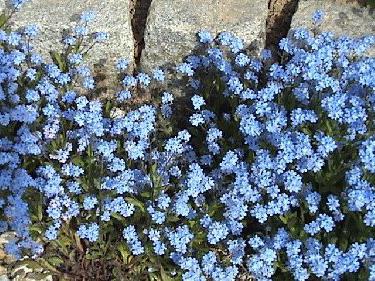

The forget-me-not flower is very responsive to feeding. The description of the requirements for caring for this plant includes the mandatory application of various fertilizers.
Soil and planting site requirements
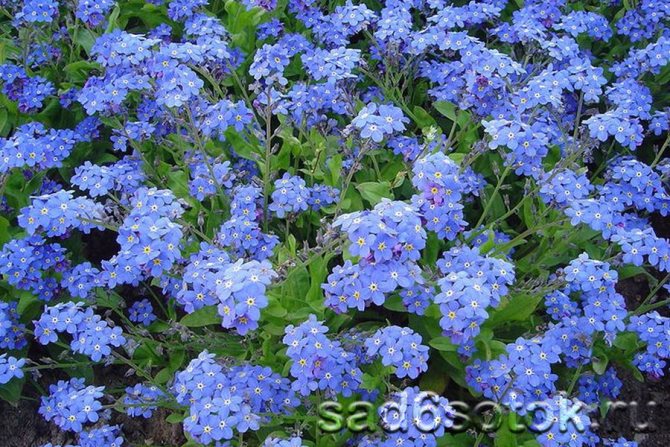

Growing forget-me-nots
Forget-me-nots are quite unpretentious flowers, they can be transplanted even during flowering. They are frost-resistant, ideal for decorating rock gardens and rockeries. They tolerate winter well, they do not need additional shelter. Almost all types of forget-me-nots grow well in the shade, bloom for about two months, in a sunny area the flowering period is shorter, there are only two light-loving varieties of forget-me-nots - alpine and field. Swamp forget-me-not tolerates high humidity, can grow in shallow water and will serve as a good decoration for reservoirs.
The soil for growing forget-me-nots should be moderately moist; in waterlogged areas, the flowers will be very long and will hurt. In too nutritious soil, forget-me-nots will grow quickly and bloom poorly, so there is no need to often fertilize the soil.
Landing
To get flowering plants in spring, it is recommended to sow seeds already in autumn. A soil mixture is poured into a container with a mandatory hole at the bottom, consisting of two-thirds of sod land and one of river sand. It is treated with a solution of potassium permanganate before sowing. The seeds are placed first in salted water to remove floating seeds. The rest must be rinsed with clean water and dried.
Forget-me-not is a flower, which is planted directly on the surface of the soil without deepening, just the seeds are lightly sprinkled with earth and covered with paper until shoots appear. They should appear in 5-6 days. When the first true leaves are formed, the plants dive into pots at a distance of at least 3 cm from each other. After that, containers with forget-me-nots are placed in a cold greenhouse until March, then transferred to a warm room. Plants are planted in flower beds at the end of April, at which time buds may already appear on them.
Forget-me-not - flowers that can be planted directly in the open ground. This should be done in July, after pre-fertilizing the soil with humus and peat with the addition of nitrophoska. Seeds are sown in the grooves and sprinkled with river sand.
How to care for forget-me-nots in the garden
Watering and loosening the soil
When grown in the shade, water sparingly; in the open sun, more moisture will be required to keep the leaves firm and fresh. At the end of flowering, stop watering.
To ensure oxygen access to the roots, the soil should be loosened regularly. Weed young plants from weeds, in the future they will cope with them themselves.
Top dressing
The plant does not need frequent feeding. Feed young forget-me-nots a couple of weeks after planting (it is better to use complex mineral fertilizers). In the fall, apply organic matter or complex fertilizer. Next spring, add some humus and peat to the soil.
Care for forget-me-nots after flowering
At the end of flowering, the plants lose their decorative effect, so it is better to remove annual species, for self-seeding it is enough to leave a few bushes. Control this process: plant young plants, avoid thickening of plantings, because with a strong growth, forget-me-nots turn into a weed.
Young shoots appear near the faded bush. They can be used for transplantation. Avoid thickening plantings of forget-me-nots, which can overgrow and displace other plants.
Diseases and pests
In the case of improper care, forget-me-nots can be susceptible to various diseases. Flowers, photos of which are striking in their delicate beauty, when infected, lose all their decorative effect.
For example, if the required distance between plants is not observed during planting, powdery mildew may appear. This disease manifests itself as a white bloom on the leaves. Spraying with fungicides will help in the fight against it.
With excessive watering, the plant is affected by brown root rot, while the stem becomes brown in color, and the flower dies. When this disease appears, forget-me-nots should be planted in another place. If you regularly loosen the soil, ensure normal (not excessive) watering and prevent plantings from thickening, then these problems can be avoided.
Plants should be periodically inspected for pests. Aphids often settle on the underside of the leaves. The presence of small ulcers on flowers and leaves indicates the defeat of the plant by a light-legged flea. In both cases, it is recommended to treat all the ground parts of the plant with karbofos (at the rate of 2 g per 10 m 2) or any other special preparations recommended in the store.
The forget-me-not flower does not cause special problems during cultivation. The above description of proper care for this plant will help to avoid many unpleasant moments.
Home care
Forget-me-not grows and feels great in natural conditions, therefore it is an unpretentious plant. It is usually grown in a garden or in a greenhouse.
Lighting
Although it is believed that forget-me-not flowers grow well in the shade, they still need sunlight. It is necessary to provide conditions when the grown flower is in the sun from 3 to 6 hours a day, partial shade conditions will be ideal. In this case, flowering will be more abundant.
Taking into account the recommendations, in the garden you need to choose a place where the flower will be half a day in the sun and half a day in the shade. In the room, they choose the south side, not forgetting to curtain the windows in time. You also need to remember about regular ventilation.
Watering
Forget-me-not is more demanding for watering. It grows well only in moist soil, so it should not be allowed to dry out. It is better to water infrequently - about 1 time per week, but abundantly, well moistening the soil. Regular spraying of the flower with warm water is allowed. The regularity of watering is calculated based on external conditions. If the forget-me-not is in the sun for a long time, you need to water it more often, if in the shade - less often.
Diseases and pests
Due to their natural endurance, forget-me-nots are less susceptible to diseases and pests. Problems can arise from improper care. If you often water and allow the soil to acidify, fungal diseases can develop - gray rot, powdery mildew. In this case, spraying with fungicides will help.
Healing properties
If we talk about medicinal properties, then there is very little confirmed scientific data on this issue.
- But traditional Chinese medicine recommends using forget-me-not to:
- calming the nervous system;
- relaxing and improving sleep;
- lowering blood pressure;
- preventing wrinkles and age spots on the face;
- improving vision;
- cleansing the liver;
- normalization of metabolism;
- increase immunity.


For this, forget-me-not petals are harvested and tea is prepared in combination with rose petals and honey.Tea is brewed in the morning and drunk during the day. For cooking 1 tsp. dry raw materials are immersed in a glass of boiling water for 5 minutes, and then served to the table, adding honey to taste.
Important! In Great Britain they make syrup from petals and give it to patients with lung diseases.
Legends and beliefs
In many European countries, in ancient times, forget-me-not was honored as a special plant and even celebrated in her honor. In Russia, this flower was also called a pristine, feverish and witching herb. Our ancestors believed that if you put a wreath of forget-me-nots on your beloved, then he will bewitch him stronger than any witchcraft.


In Germany, there is still a widespread belief that the garden forget-me-not can open a treasure, and also help to find out the name of the betrothed. Blacksmiths in many countries believed that steel, hardened in the juice of this fragile plant, became stronger and lighter, and a blade from it could cut iron.
Growing forget-me-nots
For growing forget-me-nots, it is important to choose the right place. They belong to shade-loving plants; in open sunny areas, the flowering period is halved. Common species, for example, oak or marsh forget-me-not, can be planted in lowlands or places where groundwater is close. Hybrids are less tolerant of waterlogging, so they are planted higher or the soil is drained.
Forget-me-nots develop as biennials: in the first year they form a rosette of leaves, in the second they bloom. At the same time, they do not tolerate severe frosts, therefore, they are grown by seedlings.
When to plant seeds for seedlings
For biennial Alpine forget-me-nots, growing from seed is the best way to enjoy flowering already in the year of planting. You can purchase seed in specialized stores or collect it yourself. Seeds remain viable for up to 2 years. They begin to plant in October, then at the beginning of May the bushes will be ready to move into open ground, and at the end they will bloom.
Sowing seedlings
For germination, use loose nutrient mixtures. The following composition will be optimal: leaf soil, peat, sand, agroperlite (2: 2: 2: 1). Use wide, shallow containers with drainage holes. Sow superficially into pre-moistened and compacted soil. They are not placed in greenhouse conditions. Make sure that the soil does not dry out, if necessary, moisten it from a spray bottle with a misty stream. For the prevention of black leg, potassium permanganate is added to the water once a week to a slightly pink solution.
Seedlings appear in 2 weeks. After the appearance of the second pair of true leaves, they begin to dive, choosing the largest ones. "Laggards" are allowed to grow up. They are removed carefully using a needle or awl, taking care not to damage the fragile roots. They are planted in larger containers in grooves, maintaining a distance of 3-4 cm. After a dive, the seedlings need a cool temperature, about 5-10 ° C, otherwise they will die. It is difficult to fulfill this condition on home windowsills, therefore, when growing forget-me-nots from seeds, heated greenhouses are needed.
In March, when the forget-me-not bushes grow up, they dive into separate containers into the same soil mixture. The temperature is raised to 16-18 ° C. In the process of growing seedlings, it is important not to allow the earthen coma to dry out and continue regular processing with potassium permanganate. Plants affected by blackleg are removed immediately to prevent an outbreak. In May, young growth can be planted in flower beds.
Flowers with which forget-me-nots are combined
Garden forget-me-nots are planted in groups, interspersed with taller plants blooming at the same time. These can be daffodils, tulips, lilies of the valley and other spring bulbs. Forget-me-nots are perfectly combined with shade-loving garden greenery - ferns, volzhanki, hosts. It is also used in single plantings when decorating backyard ponds, creating rockeries or alpine slides. On the same site with forget-me-nots, you can plant viols, marigolds or calendula.They perfectly coexist, not oppressing the growth of each other, and with the arrival of summer, such a blue flower garden will turn into yellow-orange sunny colors.
Landing site preparation
Two weeks before planting forget-me-nots, the site is dug up, carefully choosing the roots of all weeds. Loose with a rake. Heavy soils are "ennobled" by adding sand and peat. It is undemanding to soil acidity. Well-burnt humus is introduced for digging. If necessary, arrange drainage channels. The earth is moistened and allowed to settle.
Sequence of planting seedlings in open ground
Planting forget-me-nots is easy:
- On the site, holes or grooves are prepared so that a distance of about 15-20 cm is maintained between the bushes. When mixed planting with viols, marigolds or calendula, the interval is increased to 40 cm.
- Expanded clay or pebbles, sand are placed on the bottom.
- Seedlings, trying not to damage the roots, are removed from the containers and placed in the planting holes.
- If the forget-me-nots were in peat cups, they are planted with them.
- Bushes do not deepen.
- Gently sprinkle with earth, trying not to damage the roots. Do not tamp.
After planting, the area is watered abundantly using spray nozzles. For 2-3 weeks, until the forget-me-nots take root in a new place, make sure that the soil does not dry out.
Diseases and pests
Just like any other plants, forget-me-nots are affected by various diseases - gray rot, powdery mildew. To combat gray rot, pruning of affected cuttings is effective. And such diseases are removed with the help of Bordeaux liquid or copper sulfate.
But it is still easier to prevent the disease than to fight it in the future. Experienced gardeners recommend getting rid of weeds more often, planting seedlings sparsely and watering systematically as needed.


In the photo, forget-me-not flowers look wonderful. One can feel their unique lightness and tenderness.


They are often used as additional elements. The deep blue color goes well with yellow roses and flowers in delicate pastel tones. A bouquet with forget-me-not flowers (pictured below) has a bright and rich contrast.
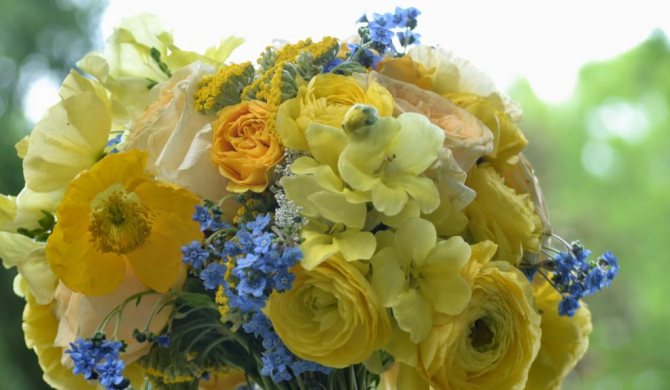

Variety of species
There are about 50 wild species of this flower. Here are the most common ones:
- Alpine forget-me-not (Myosotis alpestris)
- found in the Alps, Carpathians, in the Caucasus. The stems are low, from 5 to 15 cm, the rhizome is short. The leaves are gray-green. The flowers are dark blue. It blooms for a long time, about seven weeks. This is one of the few types of forget-me-nots that love sunlight. - Forest forget-me-not (Myosotis sylvatica)
Is a perennial plant that loves moisture and shade. Grows in the Carpathians, in Europe. It reaches a height of 30 cm. The leaves are elongated oval, the color is pale green. The flowers are light blue. Also blooms for a long time.
- Marsh forget-me-not (Myosotis palustris)
- perennial plant. Branched stems, leaves are very large, up to 8 cm in length. Blooms all summer (May-September). The flowers are pink or blue. It grows on the shores of swamps, rivers, lakes, as it loves moist soil. Found in Siberia, Transcaucasia, Mongolia, Central Europe and the Balkans.
- Forget-me-not (Myosotis arvensis)
- used as a medicinal plant. The shoots are low, the flowers are blue, small in size (up to 0.5 cm in diameter). It blooms for a long time, from May to late autumn. It grows in the vastness of Siberia, Asia, North Africa and the Canary Islands.
- Forget-me-not Chekanovsky (Myosotis czekanowski)
- this type of forget-me-not is included in the Red Book of Russia. Occurs exclusively in the Olenek-Lena interfluve and on the left bank of the Talagan River (Kharaulakh Mountains), as well as in the north of the Verkhoyansk Range. It is difficult enough to find it even to take a photo. - Forget-me-not Rehsteiner (Vyosotis Rehsteineri)
- one of the species that spreads along the ground, forming a pale blue carpet in the meadow. Colors in April and May.Refers to perennial plants that require little or no care.
What you need to know about plant care
The care for the colors described in this article has a number of features:
- Myosotis is a frost-resistant plant that loves shade.
- Flowers prefer moist meadow, clay or sandy-clay soil, that is, plants should be watered every three weeks. Try not to overdo it, over-watering the forget-me-not can wither away.
- There is no need to weed the soil. This component of care can only harm the plant.
- The soil should be fertilized at least once a month (with organic and mineral fertilizers, you can prepare a mixture: 1 teaspoon of urea, potassium sulfate and nitrophoska, diluted in 10 liters of water).
- To prolong the flowering of the plant, do not flood the flowers, but provide them with indirect sunlight. Then the flowers will become brighter, richer.
- The main enemy of forget-me-nots, the beauty of which is visible even in the photo, is aphids, which can be dealt with in one of the many ways that we talked about.
- The above flowers are very easy to transfer transplants, quickly adapting to a new place.
If the necessary conditions are not met (lack or excess of moisture, abundant sunlight), the forget-me-nots can rot roots, dry leaves and wither flowers.
What plants to be friends with
Forget-me-not is combined with many colors:
- daffodils;
- pansies;
- tulips;
- ferns;
- daisies;
- ornithogalums.
One of the most traditional combinations is forget-me-not and tulips.
How to grow forget-me-nots (video)
As you can see, in the garden or front garden, forget-me-nots are simply necessary plants. They are unpretentious, that is, they will take root in any shaded place where you want. Caring for them will not take long. And of course, they are extraordinarily beautiful. The soft blue color will delight you for at least the whole May, and some varieties will flourish until late autumn. Having planted such a plant in yourself, you will find a submissive long-liver of your flower beds.
For many gardeners, this blue flower is an integral sign of spring, indeed the forget-me-not dove is a May queen, with the smell of a meadow, forests, and a village. Its numerous blue flowers are an extraordinary decoration for any part of the garden. Forget-me-not is widespread in Russia. Every year, at the very beginning of summer, blue glades of these flowers appear on the edges, meadows, lowlands and near streams. But gardeners mainly grow hybrid varieties of forget-me-nots. For two years, forget-me-not grows in the garden, since in the third year the stems are strongly stretched, and the flowers become smaller. Plants grow in height from 20 to 35 cm. Leaves are small, pointed. Numerous flowers are blue and blue, rarely pink and white. Forget-me-nots in group plantings, matched by color, are especially impressive: such a blue, such a blueness that you can't take your eyes off, so they are grown in all kinds of flower beds, lawns near mini-ponds and streams, as well as in shady wet corners of the garden. These delicate wonderful flowers are combined with early blooming daisies, tulips, daffodils, pansies, etc. GROWING and CARE.
Forget-me-nots grow best in semi-shady places, but if kept in a moist, loose state, they grow well in open places, on humus, light soils. It should always be moderately moist, but not blocking, so that waterlogging does not cause rotting of plants or excessive stretching of the stems. Therefore, the soil must be well ventilated. Forget-me-not has a positive attitude to watering. It must be remembered that when dry, the flowers quickly fade. When watering during flowering, the stream is directed below the plant. Forget-me-not is propagated by seeds, sowing in open ground in July. Before sowing, after digging, humus, peat (up to 5 kg / sq. M), as well as 1 tablespoon of nitrophoska are added to the soil. For the second time, everything is dug to a shallow depth (10-12 cm), leveled.Water the grooves with a solution of "Agrico-ly-7" (1 teaspoon per 10 liters of water), then sow the seeds, close them up with river sand, carefully tamp them and cover them on top with a covering material until germination. Seedlings appear in 14-15 days. Then the material is removed. In the fall, forget-me-not is mulched with peat to avoid freezing, in the spring, plants are planted in a permanent place according to a 15 x 15 cm scheme, several plants per hole. With this planting, they form a real dense carpet of leaves, and then - of blue, sky-colored flowers. 15 days after planting forget-me-nots, light fertilizing is carried out before flowering: in 10 liters of water, dilute 1 teaspoon of mineral fertilizer "Agricole-7", organic fertilizer "Flower" and liquid fertilizer "Izumrud", consuming 5 liters per 1 sq. ... m. Forget-me-not is fed with organic and mineral fertilizers: 1 teaspoon of urea, potassium sulfate and nitrophoska is dissolved in 10 liters of water, spending 2 liters per 1 sq. m (top dressing is done in early May). You can repeat this top dressing once in the fall and in the spring, pour a mixture of compost and peat with a layer of 3-5 cm to the plants. Forget-me-not is affected by gray and root rot, real and downy mildew; It is damaged by several species of aphids, cruciferous flea beetles, scoops and slugs. Control measures. In order to avoid root rot, the plant is sprayed 10 days after germination with the preparation "Khom" (for 10 liters of water 40 g), the consumption is 2 liters per 10 square meters. m. Against powdery mildew effective drug "Skor" (2 ml per 10 liters of water) or "Topaz" (4 ml per 10 liters of water). Solution consumption - 1 liter per 10 sq. m. Spray against aphids with the preparation "Iskra" - 1 tablet per 10 liters of water
Forget-me-nots. (B.S.Fyodorov.)
For the first time, I drew attention to forget-me-not as a flower culture in the most unexpected way. While weeding potato ridges, I suddenly saw modest sky-blue flowers that I immediately liked. The leaves were lanceolate, tender. The highly branched bush itself did not rise much above the wooded potato tops. This was the wooded forget-me-not, widespread in our wooded area. We did not sow it, we did not specially look after it, and it, spreading by self-seeding everywhere, presented us every year with delicate, modest flowers numerous on the stems. And this lasted a whole month - from mid-May to mid-June. You used to hoe potato beds, and now and then you come across wonderful forget-me-not bushes. They grow like a weed. It would be necessary to weed out, remove, but the hand does not rise to such beauty. So he left these flowers pleasing to the eye and soul for many years. Then, having studied the cultivation technology, he began to allocate places for forget-me-not on the garden plot - somewhere in the rabatka, in the form of a border and in groups. Good forget-me-nots were also planted in pots, flower boxes on the balcony and window sills. Wonderful are obtained from it in early spring and bouquets of cut flowering plants that stand in a vase for 10-12 days. The biggest mistake.
Observing the technology of growing forget-me-nots, I try to constantly maintain the conditions in which they feel great in the shade of the tops of the same potato, that is, with sufficient moisture and shade. Having studied the soil conditions, I came to the following conclusion: forget-me-nots grow well in semi-shady places on loose, moist and nutritious soils. With dry soil, they require abundant watering, otherwise, as I noticed, they quickly fade. This is not always attributed to novice growers, this is their main mistake. A real forget-me-not is a biennial. I drew attention to the fact that planted on nutrient-poor soil, it must certainly be fed with mineral or organic fertilizers. A very beneficial effect on this flower plant was the introduction of 10 grams of ammonium nitrate, 15 grams of superphosphate and only 5 grams of potassium chloride per square meter.I sometimes replace this mixture with nitrophos and add it at the rate of 30 grams per square meter. It was also noticed that irrigation with mullein dissolved in water 1:10, the introduction of humus and mulching of the soil with peat in a layer of 3-4 centimeters have a very beneficial effect on the development of plants. Forget-me-nots can be propagated by seeds and dividing the bushes. The seeds ripen in June. Usually they crumble to the ground, and by the fall they grow into rather large bushes, which I use as planting material, planting in the places allotted to them in rabatkas, borders and flower beds. If you want to grow biennial forget-me-nots, then you need to do so. Sow the collected seeds in a prepared, well-fertilized garden bed or in boxes in early June. On the garden bed, sow the seeds into small grooves located at a distance of 10 centimeters from each other, and cover the top with soil no more than 5-6 millimeters. The garden bed should be regularly watered and shaded from the sun to preserve delicate seedlings. Seedlings usually appear in 12-15 days. When the plants have real (and not cotyledonous!) Leaves, they must be planted on other beds at a distance of 5-6 centimeters from each other with a row spacing of 10 centimeters. Further care is as follows. The soil is loosened regularly, weeds are removed, and in dry weather the plants are watered daily. In late August - early September, forget-me-nots must be transplanted to a permanent place at a distance of 15-20 centimeters. Such closeness of established plants will contribute to a continuous shelter of the earth around the forget-me-nots, which will create favorable conditions in terms of humidity and shade. By the way, we note, as our experience has shown, forget-me-nots can be planted in a flower garden not only in autumn, but also in spring.
Distillation.
This means growing forget-me-nots in pots or other containers for winter and spring flowering, that is, frankly speaking, by the time when there is an obvious deficit in flowers. Seeds are sown in boxes in late May - early June and placed in a cold and always shaded greenhouse. When they noticeably mature, they are transplanted into pots with a diameter of at least 10 centimeters and put back in the greenhouse for better rooting. For July and August, pots are dropped into a shaded garden bed and watered regularly. If you have a heated greenhouse, then in October plants are transferred there and kept at a temperature of only + 3-5 degrees, and when flower stems appear, it needs to be raised to + 12 degrees. We managed to maintain this even without a heated greenhouse, and in a well-insulated, sometimes, however, heated shed. When it got very cold, the pots with forget-me-nots were brought into the house and installed on the windowsill. In a word, for the New Year, to the delight of everyone, we had blooming dark blue forget-me-nots in our apartment.
There is also such an experience.
Forget-me-not bushes can be planted in pots and at the end of the season for the winter placed in a ventilated basement, where, of course, the temperature does not drop below 0 degrees. In February, the plants are transferred to an apartment (house), where they bloom from March to April. In the presence of a heated greenhouse, forget-me-nots can be grown to produce cut flowers. For this, seeds are sown at the same time (in May - June) in a cold greenhouse. When real leaves appear, the seedlings are transplanted into the beds as usual in a semi-shaded place at a distance of 12-15 centimeters from each other. Here they grow until October, and then they are transplanted to a permanent place in the soil of a greenhouse or in boxes at a distance of 30 centimeters between rows and 15-18 centimeters in rows. At first, the transplanted seedlings of forget-me-nots are kept at a temperature of + 5-7 degrees and watered moderately. When flower stems appear (in December), the temperature rises to 10-12 degrees Celsius and watered more abundantly, but not excessively.During this period, it is useful to add superphosphate (15-18 grams per square meter) and potassium salt (5-8 grams also per square meter). Forget-me-not begins to bloom in January and continues to delight with its blue until the end of March. The stems must be cut so that at least a little of the lower leaves remain. This will allow you to get new flowering stems from the same bushes for a longer time. Among summer residents in central Russia, few varieties of forget-me-nots are common. Of these, we note the old ones, the most liked by the old-timers-flower growers. Blauer Korb. The color of the flowers is dark blue, the height is up to half a meter. The variety is good both for planting in a flower garden and for cutting. Indigo compact. The color of the flowers is blue, the height is 15-18 centimeters. Good for curbs and bedding. Messidor. Flowers are dark blue in color, height 30-40 centimeters, the variety blooms late, closer to autumn. Suitable for planting in a flower garden. Blaus Kugel. The color of the flowers is light blue, the height is 15 centimeters. Used in a flower garden as borders.
Pests and diseases
... Forget-me-nots suffer from a number of pests and diseases. So, often aphids appear on the underside of the leaves. Small ulcers suddenly form on the leaves and flowers. These are traces of the "work" of the light-legged flea. You can get rid of both aphids and fleas by applying malofos at a concentration of 2% (2 grams per 10 square meters). If it is impossible to use karbofos, you can use new chemicals recommended in stores. The appearance of a white powdery bloom on the leaves is a sign of plant disease with powdery mildew. Usually, this disease occurs most often with too frequent (tight) planting. This means that the disease can be avoided if the plants are not allowed to become thickened both when growing seedlings and when planting them in a permanent place. There are times when the stem turns brown at the base and the plant dies off. These are signs of brown root rot. The disease rarely manifests itself if you regularly keep the soil in a loose state and observe moderate (and not excessive!) Watering. If, nevertheless, the disease did take place, then in the future forget-me-nots must be planted in a new place.
Quite often this humble plant is called the "Queen of May". One of the legends says that these blue flowers are scattered over the earth by angels so that people at least occasionally remember the sky.
In addition, despite the fact that in different languages it is noticeably different, for all peoples it has practically the same meaning - "do not forget me." In this article, we will tell you how to grow such a touching perennial that symbolizes devotion and loyalty, like the garden forget-me-not.
Spread
Representatives of the genus Myosotis are distributed throughout Europe and Siberia. In the Asian part of Russia, they are not found only in Chukotka and Kamchatka. In the lower reaches of the Lena River, on the slopes of low ridges, they find the rare Chekanovsky forget-me-not.
The creeping forget-me-not has a broken range: part of the species lives in Karelia and the Scandinavian countries, part - in the Alps and Pyrenees. Field forget-me-not is widespread: Europe, Siberia and North Africa make up its natural range, as an alien species, it has settled in North America, Australia, and large islands. The garden form of plants of this genus is cultivated almost everywhere.
Forget-me-not beauty (video)
The number of varieties of forget-me-nots is estimated at five dozen, among which there are both annuals and biennials, and perennials. Forget-me-not grows with pleasure on all continents, except, of course, Antarctica. The height of the stems reaches 40cm.
Most often, forget-me-not is grown on plots as an annual crop. Seedlings appear in the second or third week after sowing.
As for annual forget-me-nots, they grow in the Caucasus, where they are found in mountain forests.Allocate the related forget-me-not, Lazistan and pleasant, which is a perennial, but is grown as an annual.
Other varieties of this flower are worth mentioning. For example, the Alpine forget-me-not is a wild species and has not yet been domesticated. But the alpine garden forget-me-not just pleases gardeners with abundant flowering for two years. The most famous varieties are Victoria, Carmen King and Blue Ball. Marsh forget-me-not is a perennial; such varieties as Thuringen and Semperflorens are known.
Photo gallery of forget-me-not varieties


Forget-me-not grade "Carmine King"


Forget-me-not grade "Ultramarine"
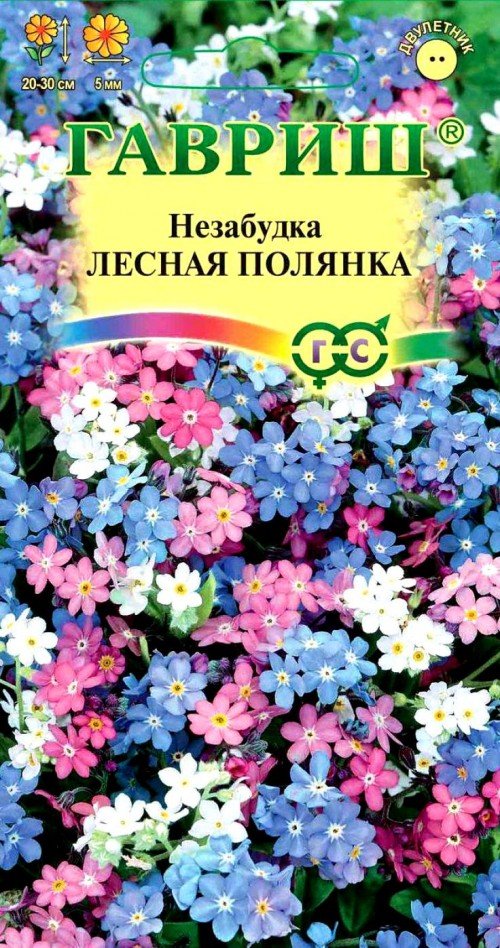

Forget-me-not grade "Lesnaya Polyanka"
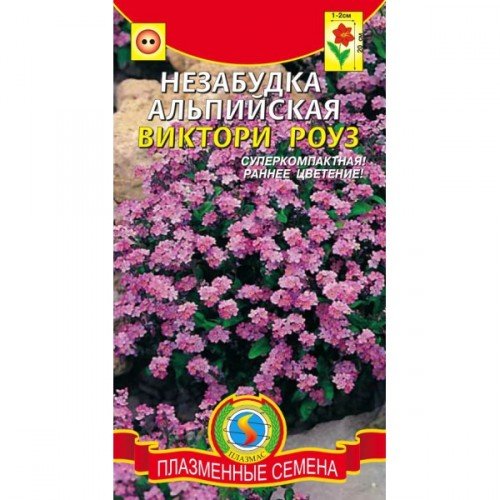

Forget-me-not variety "Victory Rose"
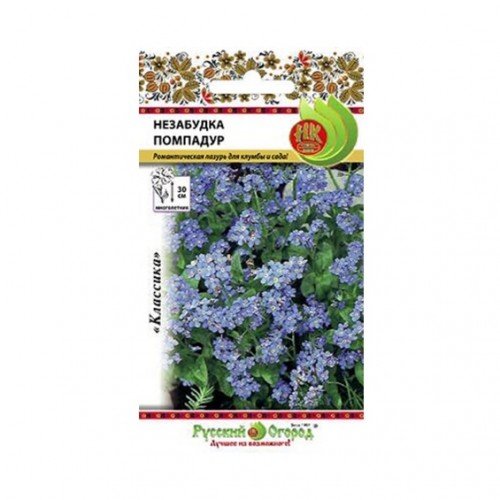

Forget-me-not grade "Pompadour"
The forest forget-me-not has many varieties with blue, pink and blue flowers. Amateur gardeners are familiar with the Blue Bird variety, grown as a biennial. Another type of forget-me-not that grows for two seasons is the set-flowered forget-me-not, which has large flowers.
Another perennial - forget-me-not Pompadour - will perfectly decorate various flower beds, rabatki, lawns and balconies. Growing up to 30cm in height, it lives well in shady places and easily survives the winter without shelter.
Growing features
As a rule, there are no problems with forget-me-not when growing, but for their healthy growth, you need to follow some rules. First of all, thickening of the plantings should not be allowed, it is imperative to periodically loosen and prevent waterlogging of the soil. Otherwise, forget-me-not can get sick with gray or root rot, as well as become covered with downy mildew or powdery mildew. You can get rid of powdery mildew with the help of fungicides, 2 ml of which are diluted in 10 liters of water, and then the plants are sprayed with this composition.
Various pests such as aphids, scoops, cruciferous fleas and slugs are expelled using insecticides, which are also sprayed on plants.
What kind of care is needed
Forget-me-nots are resistant to spring frosts, shade-tolerant and frost-resistant. Shaded areas are considered the best conditions for flowering. Therefore, forget-me-nots can be planted together with tall and spreading, ornamental plants such as ferns. In the sun, the blooming period of forget-me-nots will be less, only 20 days. The sun is favorable only for the field and alpine forget-me-nots.
Forget-me-nots are cultivated as biennials. Perennial plants from the third season stretch and fade.
For flowers to grow, moist clay, sandy-clay or meadow soil is needed. However, forget-me-nots can suffer from excess moisture from watering or after rain. Weeding in flower beds with forget-me-nots is not required, as it can harm a plant with a fibrous root and a dense mass of intertwined roots.
Top dressing is applied monthly, alternating mineral and organic composition. The mixture is prepared from potassium sulfate, urea and nitrophoska, a teaspoon per bucket of water. The first time fertilization is applied 2 weeks after planting, then before flowering and in autumn. In the spring, a layer of rotted compost and peat is added under the planting. An excess of fertilizer enhances the growing season and reduces the abundance of flowering.
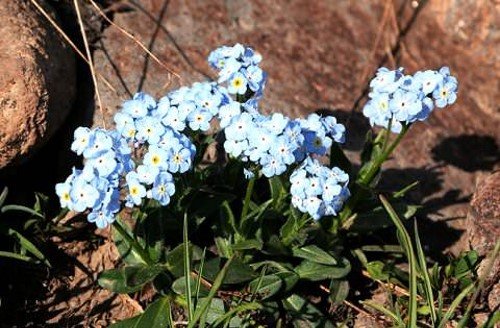

Care.
It is not difficult to care for a flower if it is planted in suitable soil. Forget-me-nots, all except for the marsh, do not tolerate the close occurrence of groundwater and waterlogging. Therefore, after each watering and rains, it is important to loosen the soil.
Fertilizers are applied 2 times a month, combining this procedure with watering. After flowering, it is better to destroy annual forget-me-nots, since their stems and foliage do not retain their decorative effect and will spoil the overall composition.
Perennials before the onset of frost are cut almost to the root, and covered with spruce branches. As a rule, forget-me-nots tolerate winters well, but if the temperatures are too low, or a little snow falls, they may die.
Reproduction.
Forget-me-nots reproduce well by seed and retain varietal characteristics.But when it comes to hybrid varieties, it is better to propagate them vegetatively in order to get the desired variety as a result.
Forget-me-not is propagated by dividing the bush and apical cuttings. Dividing and grafting can be done at any time of the year, except for winter. Perennial varieties of forget-me-nots need regular planting every 4-5 years, otherwise the flower loses its decorative effect.
Chemical composition and application
Forget-me-nots are not included in the state Pharmacopoeia of the Russian Federation, they are not used in official medicine, their chemical composition is poorly studied. It is known that the herb of the plant contains up to 6% tannins that suppress the growth of pathogenic microflora. In addition, the leaves accumulate anthocyanins, saponins, flavonoids, linoleic acid, a sufficient amount of potassium and other trace elements.
In folk medicine, field forget-me-not is used. Decoctions of plants wash the eyes with conjunctivitis, allergic reactions, inflammation of the lacrimal glands. They also make lotions and baths for dry eczema, skin rashes of various etiologies.
The name "febrile herb" justifies the use of its infusions and decoctions for exhausting coughs, tuberculosis, colds with profuse night sweats. According to some reports, the plant-based remedies help with snake and scorpion bites, and also contribute to the healing of some types of malignant tumors.
Forget-me-not is a component of homeopathic remedies for eliminating the causes of gastrointestinal disorders and increased fatigue.
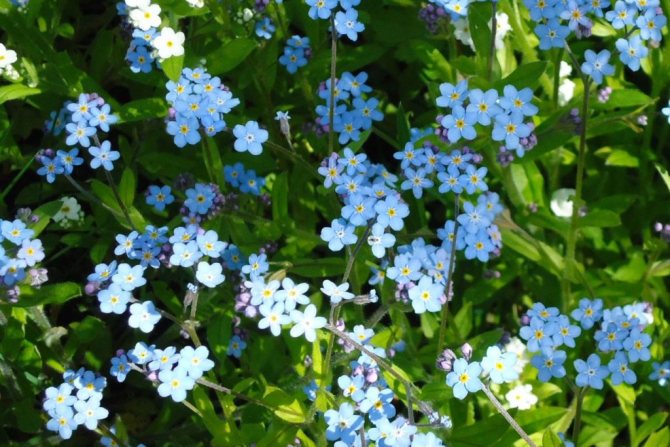

In folk medicine, field forget-me-not is used
Forget-me-not in landscape design
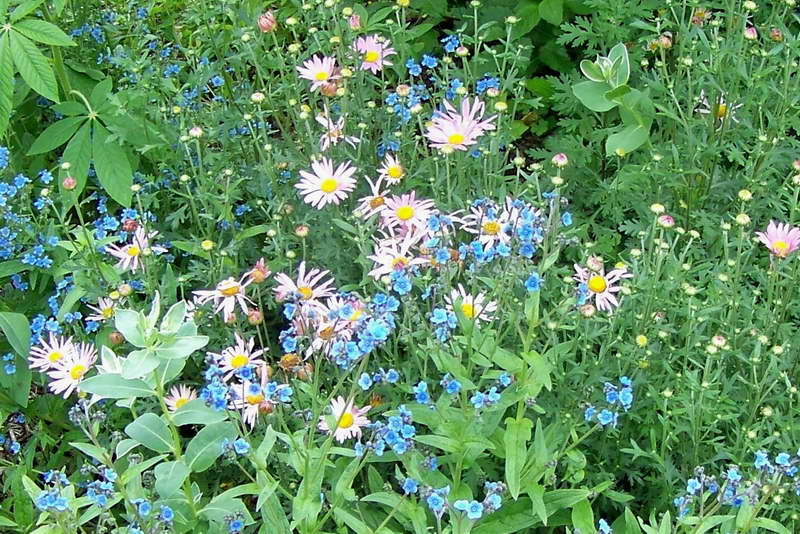

Forget-me-not in landscape design photo
A touching forget-me-not is an indispensable decoration of a spring flower bed, it is planted near the water (swamp forget-me-not can grow in shallow water), it is also grown as a container culture. Forget-me-not looks good in rockeries, on alpine slides, in border plantings.


Forget-me-not in landscape design photo
The combination with daffodils and tulips is a safe bet. Not a bad company will be made by pansies, daisies, yellow violet. They are planted with lilies of the valley under the canopy of trees - by the end of spring such a flower garden will become the most amazing part of the garden. After their flowering, the place will be decorated with taller shade-tolerant plants, for example, hosta, Kamchatka meadowsweet, Volzhanka, female duckweed, male duckweed.
We create conditions
After the plant has been planted in a permanent place, it needs to be provided with moderate regular watering and fertilizing with mineral fertilizers. When watering, you should try not to get water on the plant itself, but direct the stream closer to the roots.
The first feeding is carried out before flowering, about 14 days after planting the plant in a permanent place. Complex mineral fertilizers dissolved in water according to the instructions are suitable for this purpose. In the fall, both organic and in the spring, a small, about 5 cm, layer of peat-mixture or well-rotted compost mixed with garden soil is poured into the soil under forget-me-nots. It is important to remember that garden forget-me-not is quite aggressive and spreads quickly by self-seeding. To prevent this, you should immediately remove the faded twigs, thereby preventing the setting of seeds and their further unauthorized "movement" in your area.
History of origin and appearance
Where the plant came from is hard to say. In one source, the homeland of forget-me-nots is called the Alps (Switzerland), in another - some regions of northern Europe. This type of plant grows on almost all continents (Asia, Europe, South America, North America and Australia), in areas with a humid climate. In nature, a blue carpet of forget-me-nots can be found on sunny meadows, on the banks of rivers and streams, and even in swamps.


Most popular flower
There are many stories and legends about the origin, each country has its own, and all tell about love, fidelity and parting with beloved ones.
From the name alone, you can already understand what a forget-me-not flower looks like - having seen it once, its gentle blue cannot be forgotten.
Forget-me-not flowers: plant appearance
Forget-me-not belongs to the genus of herbaceous plants of the Burachnikov family. The flower grows up to 30 - 35 centimeters, perennial, with branched stems and small flowers, collected in inflorescences. The flowers themselves are pale blue, pink and even white.
Name history
Forget-me-not is a flower of forests, gardens and front gardens, small and delicate with petals the color of the sky and a sunny heart. It is also called "mouse's ear", this is how "Myosotis" is translated from Latin. Popular names are as follows:
- gourd;
- febrile grass;
- good-looking.
According to legend, Flora, the goddess of the entire plant world, did not notice the small flower and forgot to give it a name. Unnoticed, he got scared and began to quietly repeat: “Do not forget me!” Having heard this, Flora, smiling, gave him a name - Forget-me-not. Since then, people began to claim that he has the ability to bring back forgotten memories. But this is just a legend.
It is not known exactly why forget-me-not is called that, but from almost all languages the name has the same translation, and means: "Do not forget me, please!".
The flowering period lasts almost five months, from May to the end of September, it all depends on the variety.
Reproduction through seedlings
Usually, the cultivation of garden forget-me-nots through seedlings is carried out for annual varieties, such as, for example, Mon Ami Blue. Seeds are sown superficially in prepared containers with well-moistened soil in late March - early April. For seedlings, a special soil mixture is made, consisting of fine river sand and sod land in a ratio of 1: 2. Before the emergence of seedlings, containers with seeds, covered with glass or polyethylene, are kept at a temperature of + 20 ... + 23 0 С, and after five days it is lowered to + 18 ... + 20 0 С. All this time the seedlings should be well illuminated.
After the emergence of sprouts, fertilizing can be carried out with weak solutions of mineral fertilizers and watered as the top layer of the soil dries up. In May, seedlings, often already with buds, are planted in open ground, sheltering them for the first time both from the scorching sun and from recurrent frosts. By the end of July, the plants will have faded and their seeds will ripen.
How to plant a forget-me-not
Growing forget-me-nots will not give you much difficulty.
When planting seeds
- It is better to plant seeds directly in open ground.
- The best time for planting is July.
- The most important thing to do for the seeds before planting is to fertilize (add humus mixed with peat) and moisten the soil. Also, the soil needs to be loosened and dug up.
- Next, you should form small holes and place the seeds there, sprinkle with a small amount of sand (to form a thin layer of sand above the hole).
- It is advisable to cover the seeds with a covering material. After two weeks, it will need to be removed.
When planting cuttings and seedlings
- Prepare the soil - dig up, loosen, fertilize and moisten.
- Land - the forget-me-not will take root.
Forget-me-not flower: description and varieties
In our area, there are forget-me-nots field and marsh. A feature of this type is unpretentiousness. Flowers can often be found in fields, gardens and gardeners' regular beds. This plant is quite common, and almost everyone knows what a forget-me-not looks like. For normal life, the plant needs a moist soil. However, depending on the species, some thrive well in shady places, while others, on the contrary, germinate well under the sun. There are also species that are designed to live at home - indoor pots. Outwardly, they are absolutely no different from the field.
An excerpt characterizing the Forget-me-not creeping
Prince Andrey spent two years without a break in the village. All those enterprises by names that Pierre started at himself and did not bring to any result, constantly moving from one case to another, all these enterprises, without showing them to anyone and without noticeable difficulty, were carried out by Prince Andrew. He had in the highest degree that practical tenacity that Pierre lacked, which, without scope and effort on his part, set things in motion. One estate of his three hundred souls of peasants was listed as free farmers (this was one of the first examples in Russia), in others corvee was replaced by rent. In Bogucharovo, a learned grandmother was discharged at his expense to help the women in childbirth, and the priest taught the children of peasants and courtyards for a salary. One half of the time Prince Andrew spent in Bald Hills with his father and son, who was still with the nannies; the other half of the time in the Bogucharov monastery, as his father called his village. Despite his indifference to all the external events of the world he showed Pierre, he diligently followed them, received many books, and to his surprise he noticed when people fresh from Petersburg, from the very whirlpool of life, came to him or to his father, that these people, in the knowledge of everything that is happening in foreign and domestic policy, they lagged far behind him, sitting without a break in the countryside. In addition to studying the names, in addition to general studies of reading a wide variety of books, Prince Andrey was at this time engaged in a critical analysis of our last two unfortunate campaigns and in drawing up a project to change our military regulations and decrees. In the spring of 1809, Prince Andrey went to the Ryazan estate of his son, whom he was a guardian. Warmed by the spring sun, he sat in his carriage, looking at the first grass, the first birch leaves and the first puffs of white spring clouds that scattered across the bright blue of the sky. He did not think about anything, but looked around cheerfully and meaninglessly. We passed the ferry on which he had spoken to Pierre a year ago. We passed a dirty village, threshing floors, greening, a descent, with the remaining snow near the bridge, an ascent along washed-out clay, strips of stubble and greenery in some places with bushes and drove into a birch forest on both sides of the road. It was almost hot in the forest, the wind could not be heard. The birch tree, all sown with green sticky leaves, did not move and from under last year's leaves, lifting them, the first grass and purple flowers crawled out, turning green. Small spruces scattered here and there on the birch grove, with their coarse eternal greenery, unpleasantly reminded of winter. The horses snorted as they drove into the forest and began to fog up better. Lackey Peter said something to the coachman, the coachman answered in the affirmative. But Peter could see little sympathy from the coachman: he turned on the box to the master. - Your Excellency, how easy it is! He said, smiling respectfully. - What! - Easy, Your Excellency. "What he says?" thought Prince Andrew. “Yes, it’s true about spring,” he thought, looking around. And then everything is green ... how soon! And the birch, and bird cherry, and alder are already beginning ... And the oak is not noticeable. Yes, here it is, an oak tree. "
Use cases in landscape
Forget-me-nots are very common in Europe. Europeans love to use them in garden compositions along with tulips and daffodils. Near a reservoir, forget-me-nots look especially impressive. On a personal plot, they can find their place in a curb flower garden and in the shade of gardens. In the city, the plant can often be seen in a pot on a balcony.
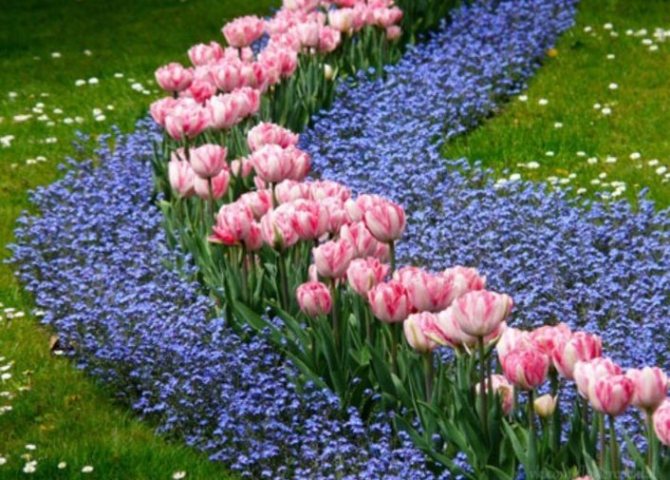

Landscape use
Thus, a seemingly miniature ordinary flower, symbolizing eternal love, fidelity and memory, is unpretentious, and this has earned it popularity among flower growers around the world.



